
7 SMS Automations to Boost Revenue (and How to Optimize Them for Your Brand)
As any good financial advisor knows, the first rule of investing is to diversify.
The same goes for your SMS strategy.
Sure, full-list campaigns can be great for driving a lot of revenue in a short amount of time—but they shouldn’t be your only play. That would be like pouring all of your savings into one investment.
Instead, it’s important to balance your SMS portfolio with different types of messages, including those specifically designed to maximize the long-term ROI of your SMS program. We’re talking about automations.
In this article (click to jump to a specific section):
Optimizing Your Post-Purchase Automation
If you get a lot of reorders, have you nailed down the timing and content of your reminders?
Do you know which upsell and cross-sell pairings drive the most engagement and sales?
Is there an opportunity to create an automation based on engagement with other automations?
Could you leverage an integration to drive more revenue through text?
Why Should I Set Up SMS Automations?
Unlike campaigns, automations are triggered by subscriber behavior. This makes them inherently more contextual and less intrusive—which often leads to higher conversion rates.
The flipside to that is it takes time to build messaging volume. A full-list campaign send might hit 2,500 subscribers at once—whereas a single automation could take weeks or months to fire 2,500 times. But in the long run, sending all of those messages to high-intent subscribers can really pay off.
The key is putting an automation strategy in place sooner rather than later. That way, you’ll start driving revenue in the background to supplement your campaign earnings.
What Does a Good SMS Automation Strategy Look Like?
A good automation strategy is an active automation strategy. Marketers often look at automations as a “set it and forget it” endeavor—one that simply does its job in the background and pulls in passive income. While that is true to a degree, you don’t want to ignore your live automations entirely. When optimized strategically and continually, automations can pay off in a much bigger way.
With that in mind, we’ve put together a list of top automations to get up and running for your brand—as well as some suggestions for continuing to optimize, expand, and iterate upon those automations as your SMS marketing program grows and matures.
Hot tip: We recommend checking in on each automation flow on a quarterly basis to analyze results and identify opportunities for enhancement.
Okay, let’s get to it. Here are seven must-have automations for your SMS marketing program—and how to use them to their full revenue-driving potential.
1. Welcome Series
First impressions matter—especially on an intimate channel like SMS. This is your brand’s shot to show new subscribers that you’re worthy of a place in their most personal messaging inbox.
Not to add any pressure (okay, maybe a little pressure isn’t a bad thing), but we know SMS subscribers are more likely to unsubscribe during their first 30 days on your list than they are at any other point during their SMS journey. And your welcome series is your number-one defense against opt-outs during this crucial period.
The revenue potential of this automation isn’t bad, either. According to our 2022 SMS Benchmarks Report, welcome series messages generated the third-highest conversion rates (after keyword opt-in replies and abandoned cart automations), with EPM (earnings per message) averaging $1.55–$6.64.
Creating Your Welcome Series
We wrote an entire blog post on creating a great welcome series for your brand, which you can check out here. The main idea is that there are many different ways to approach this flow—from slinging discounts right off the bat to inviting subscribers to engage with you via keyword replies.
Whatever route you choose, use this flow to showcase your brand’s value and personality to new subscribers. More importantly, set expectations for what else they’ll receive from you via text—whether that’s early access to sales and product drops, exclusive discounts, VIP giveaways, or staff-curated content like playlists or recipes.
This example from healthy soda brand OLIPOP incorporates a variety of welcome series strategies all in one message—a personal employee greeting, discount, and opportunity to reply with a keyword to learn more about either the OLIPOP brand story or how they make their sodas.

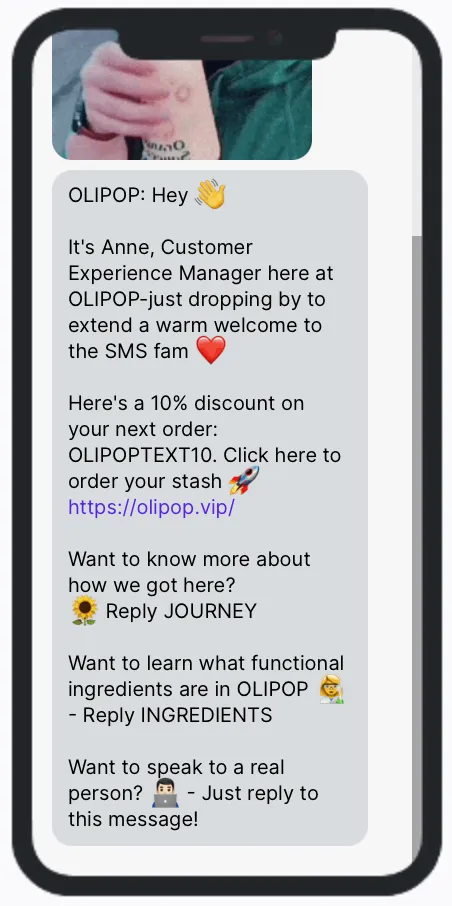
Coffee brand Wandering Bear really went all-in on their welcome series, creating a flow that delivers five messages over the course of about two weeks (provided that the recipient does not take action on any of the messages). Here’s what it looks like:
The first message reinforces the brand’s value prop and offers the subscriber a 10% discount and free shipping on their order.
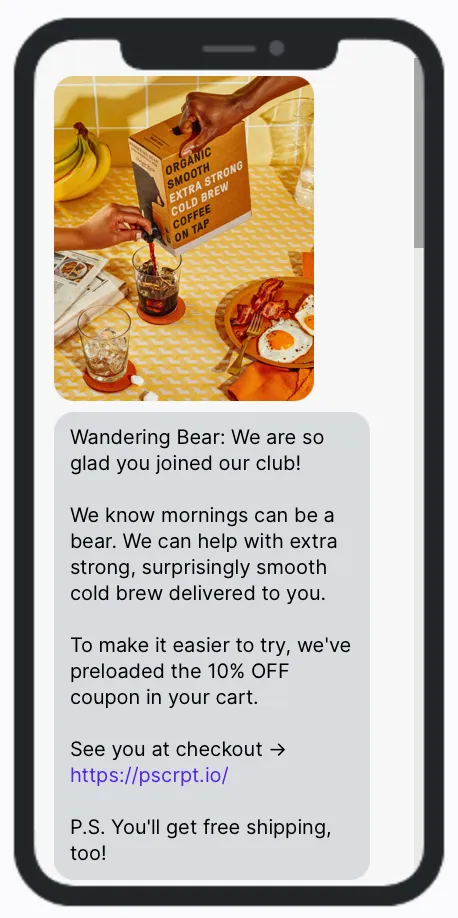
The second message educates the subscriber on the brand’s eco-friendly operations and reminds them to use their 10% discount.
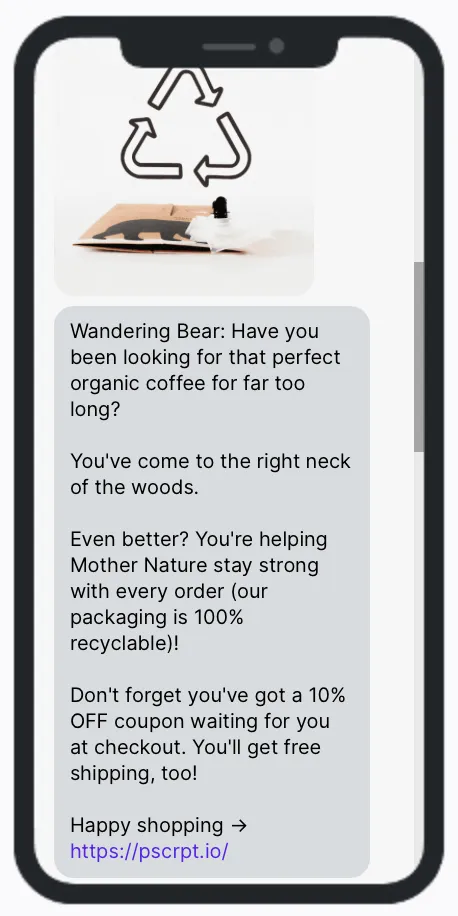
The third message goes the social proof route, touting Wandering Bear’s impressive catalog of 6,000 five-star reviews.
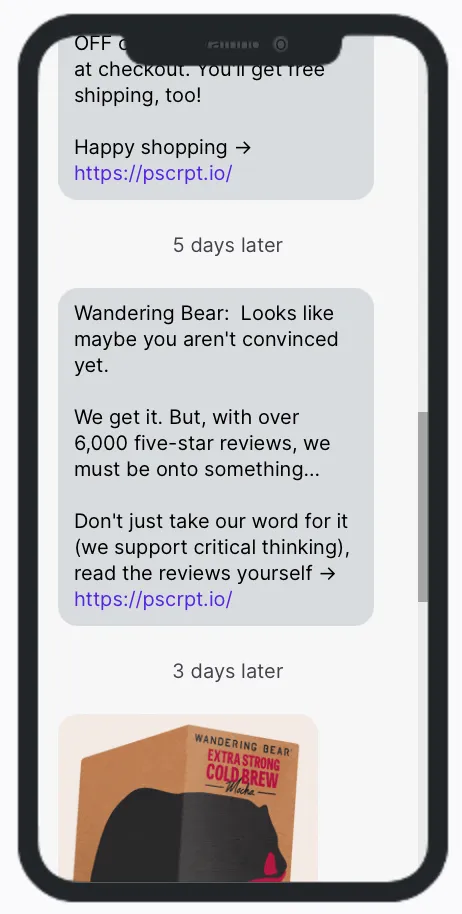
The fourth message invites subscribers to explore all of their many offerings, using variety to stoke their curiosity.
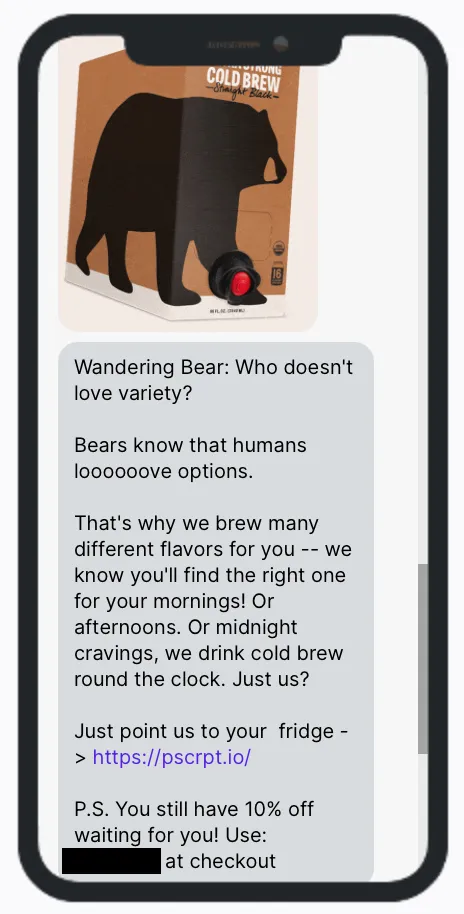
The fifth and final message leans back into the content strategy, inviting subscribers to reply with a keyword if they’d like to receive a coffee-infused smoothie recipe. (As a bonus, this allows the brand to determine whether the subscriber is still engaged.)
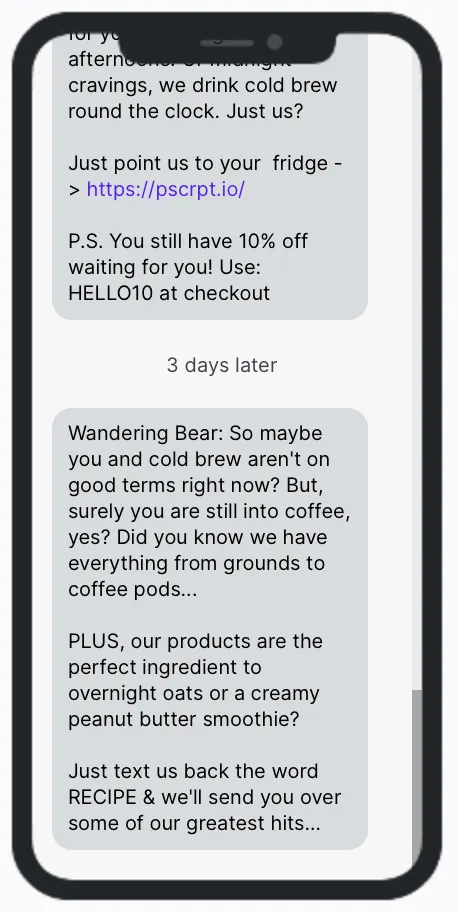
Optimizing Your Welcome Series
Okay—you’ve built out a thoughtful and engaging flow of 3–5 messages designed to engage and retain new subscribers. Well done!
Next, create variations of your welcome series to align with each individual opt-in point. This makes the subscriber’s experience more seamless and your messages more credible and trustworthy.
Here’s an example of the welcome flow men’s soap brand Dr. Squatch created specifically for new subscribers who opted in via a BFCM-related CTA.
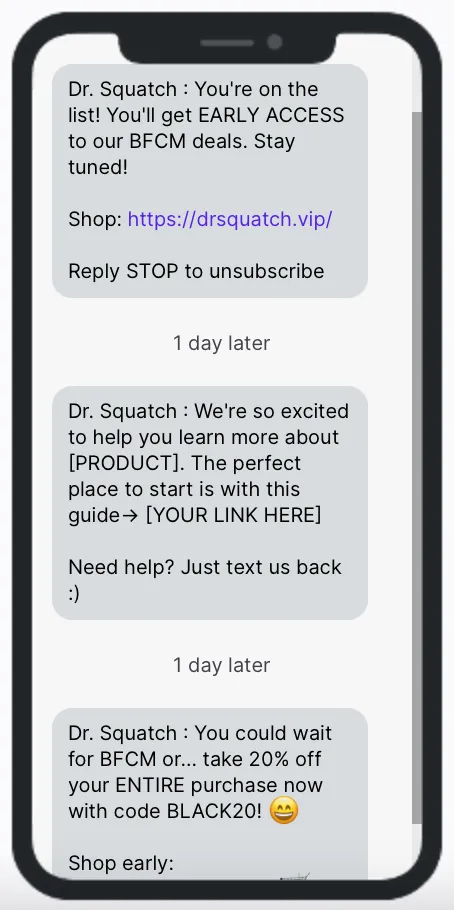
And here’s one olive oil and vinegar brand Brightland spun up for subscribers who opted in as part of a giveaway campaign.
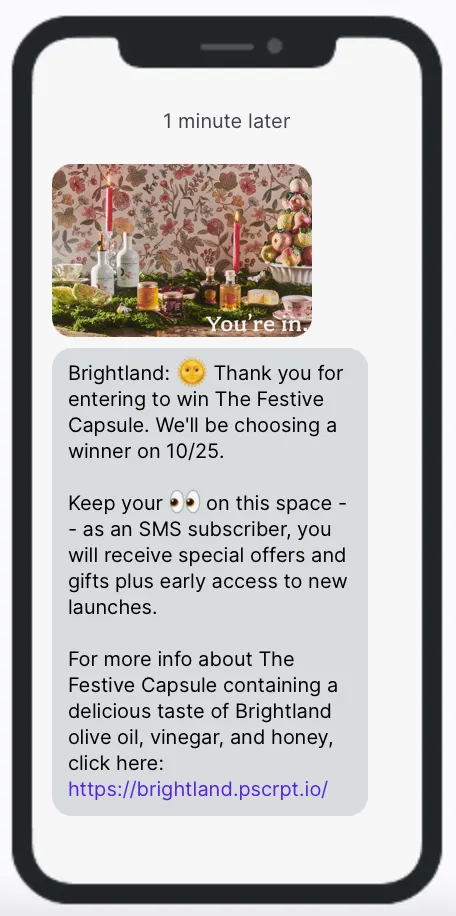
You might also consider creating different versions of your welcome series for customers and non-customers. Sustainable toothpaste brand Bite made this welcome series for current customers who are already familiar with the brand’s mission and products.
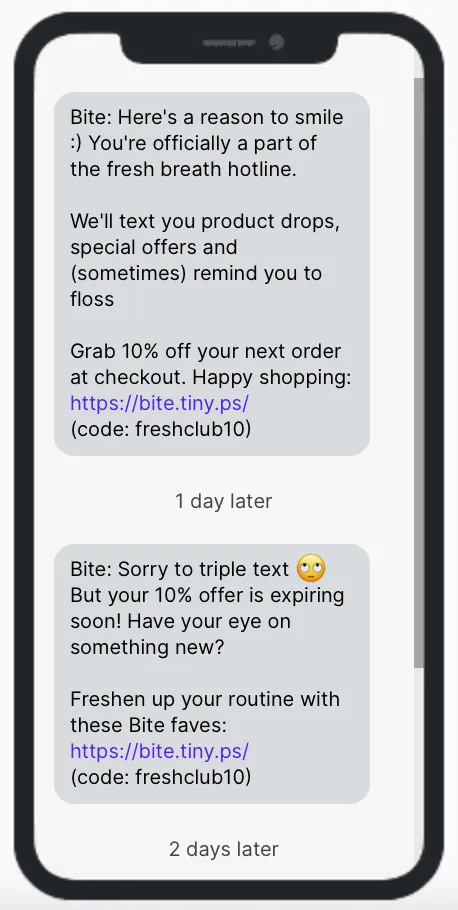
Their welcome series messaging for non-customers, on the other hand, focuses more heavily on the purpose behind their products.
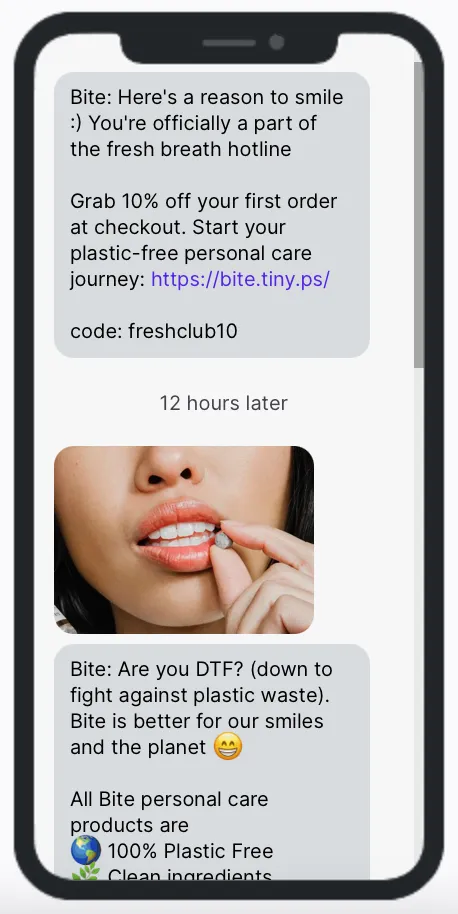

Ski brand J Skis gets super creative with geotargeting in their welcome series, sending subscribers in certain area codes message content specific to their location. (They also spark engagement by asking subscribers to respond with their favorite ski mountain—a recommendation most snowsport enthusiasts are more than happy to provide.)
Here’s an excerpt of the welcome series that goes out to subscribers located in the Pacific Northwest.
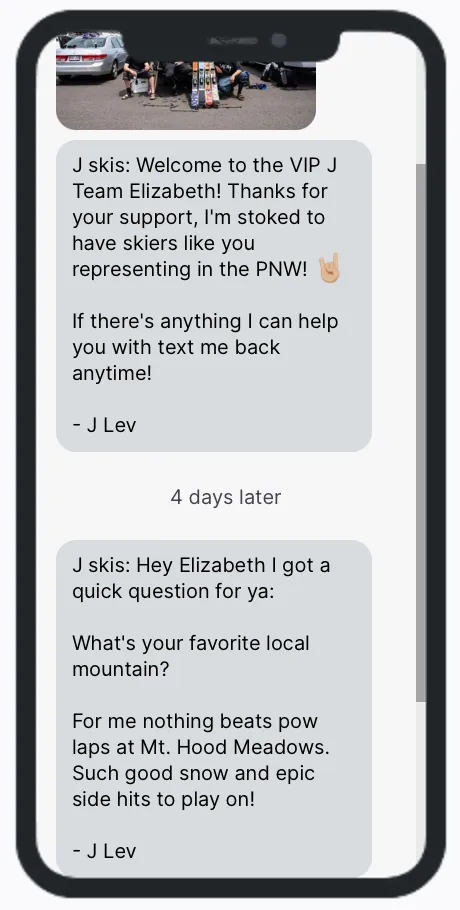
And here’s part of the series that goes to subscribers in California.
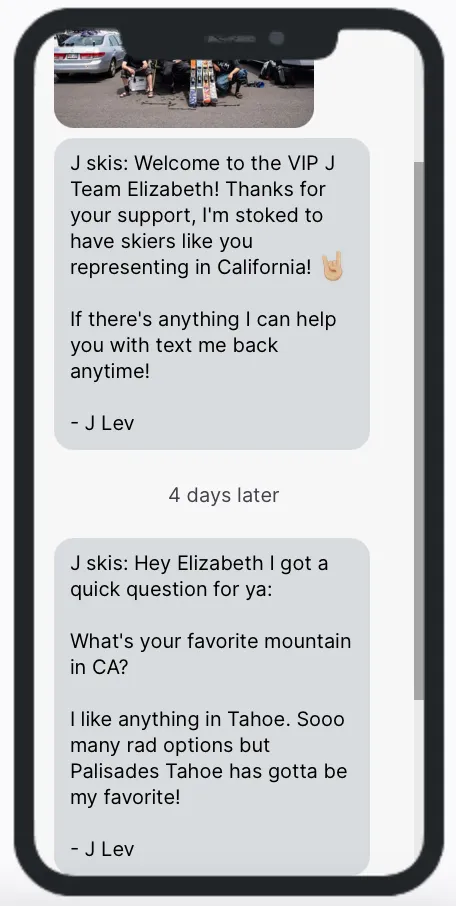
Last but not least, we highly recommend revisiting any active welcome flows on a regular (e.g., quarterly) basis to A/B test your message content and/or offers.
For example, you could test a product recommendation against a sitewide discount code—or you could test a sitewide discount code followed by a product recommendation against a personal message from the founder followed by a product recommendation. The possibilities are endless!
As we explained here, “You could also test different offers—free shipping, free gift with first purchase, various discount percentages—against one another to see which one yields the best conversion rate. Or, you could test a series with no discount offer against a series with a discount offer to see if the discount is actually effective in converting new subscribers to customers.”
In the following A/B test from Brightland, all of the message content is the same except the featured product, which is linked in the second message of the series. The first version serves up the Essential Capsule.

And the second version offers the lower-priced Mini Essentials bundle.
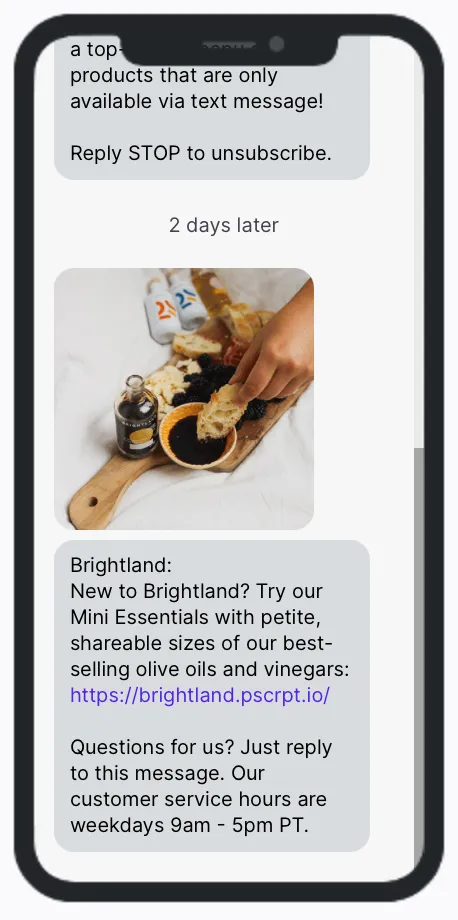
The idea behind these two “sampler” products is similar: giving new customers the opportunity to try several of the brand’s most popular items. It’s a great promotional strategy for subscribers who have yet to purchase any Brightland products.
Once they introduced the Mini Essentials, Brightland tested that new—and lower-priced—product offer against the Essential Capsule to see which product would be more effective in driving purchases.
2. Abandoned Cart
Abandoned carts are typically one of the first SMS automations brands enable, and for good reason. According to our 2022 SMS Benchmarks Report, with the exception of keyword opt-in replies, abandoned cart messages produced the highest clickthrough and conversion rates across all industries and product personas.
Additionally, the report found that abandoned cart automations generate an average EPM of $4.36–$13.79—also the highest outside of keyword opt-in replies. This all makes sense considering that a shopper who actually places an item in their cart clearly has high purchase intent. So, even the slightest push can be enough to make them convert.
Abandoned carts are obviously a no-brainer for any ecommerce brand using SMS. But, this foundational automation comes with one very important compliance caveat: shops can only send one text message per abandoned cart event. So, make it count!
Creating Your Abandoned Cart Automation
Technically speaking, your abandoned cart automation should be triggered when a checkout is started—and canceled when an order is created. You’ll want to build in a time buffer so the message doesn’t fire immediately after someone begins checking out (give folks some time to fill in their payment and shipping info before assuming they’ve abandoned ship).
This help center article walks you through creating this automation in Postscript’s Flow Builder—including adding in product names and photos, both of which can boost the impact of your message.
These messages typically include a discount—especially for recipients who have not purchased from you before—but it’s not required. You could offer something like free shipping instead—or use customer reviews and testimonials to convince hesitant buyers to take action.
For example, here’s an abandoned cart automation energy gum brand Run Gum created for new customers.
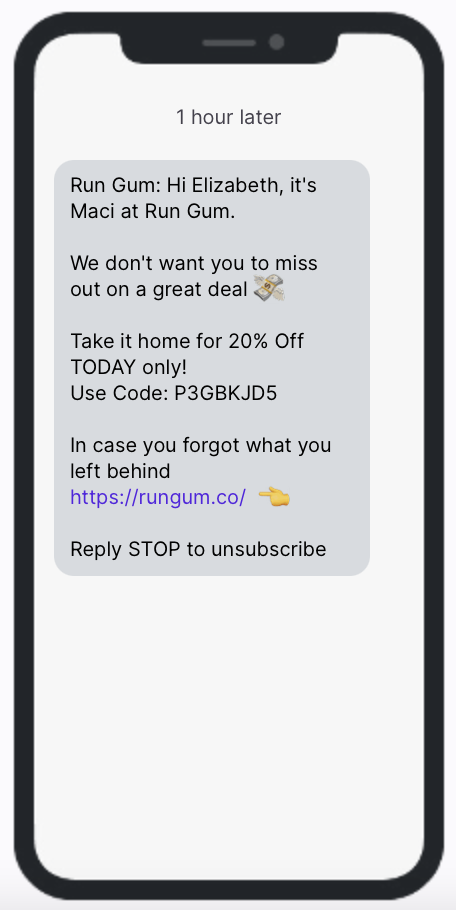
By contrast, this version for returning customers does not include the discount incentive—likely because most returning customers like the product enough to come back and shop for more, so a discount isn’t necessary to get them over the finish line.
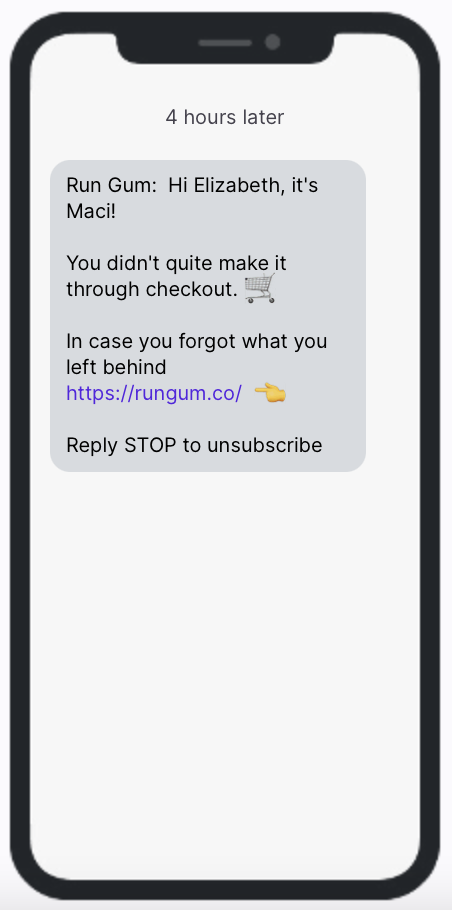
Clothing brand The Perfect Jean actually does the opposite. Here’s their abandoned cart for new customers, which leans into their brand voice and humor—rather than a discount or incentive—to win over their prospects.
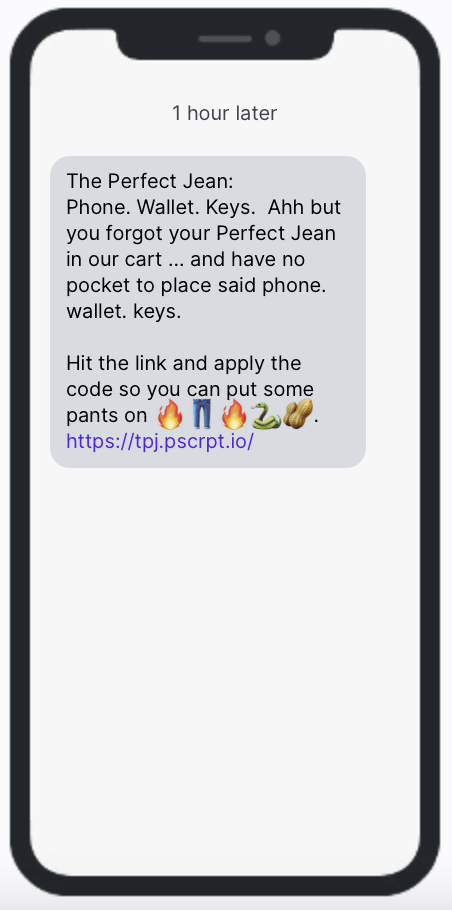
Past purchasers, on the other hand, receive the following abandoned cart message, which reinforces the value of staying on their subscriber list and rewards their loyalty as a returning customer. Not a bad strategy to try out!
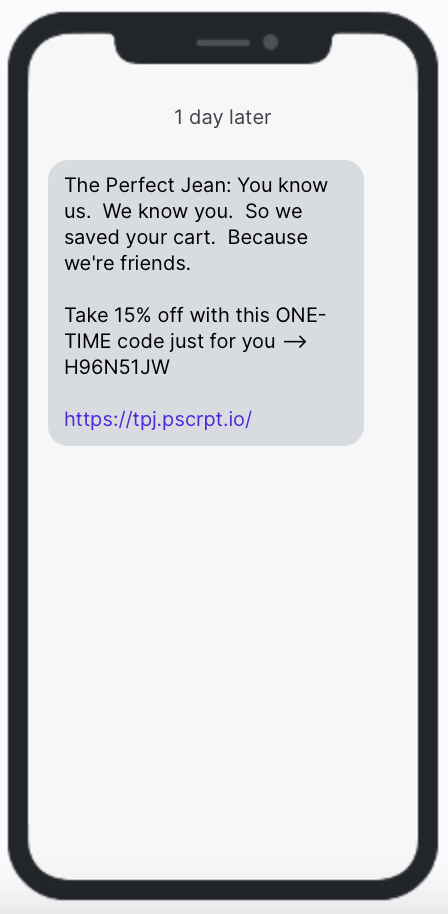
This example from Snow Teeth Whitening leverages social proof to inspire the recipient to complete their purchase. With this approach, they let the value of the product speak for itself rather than incentivizing the recipient to convert via a discount offer.
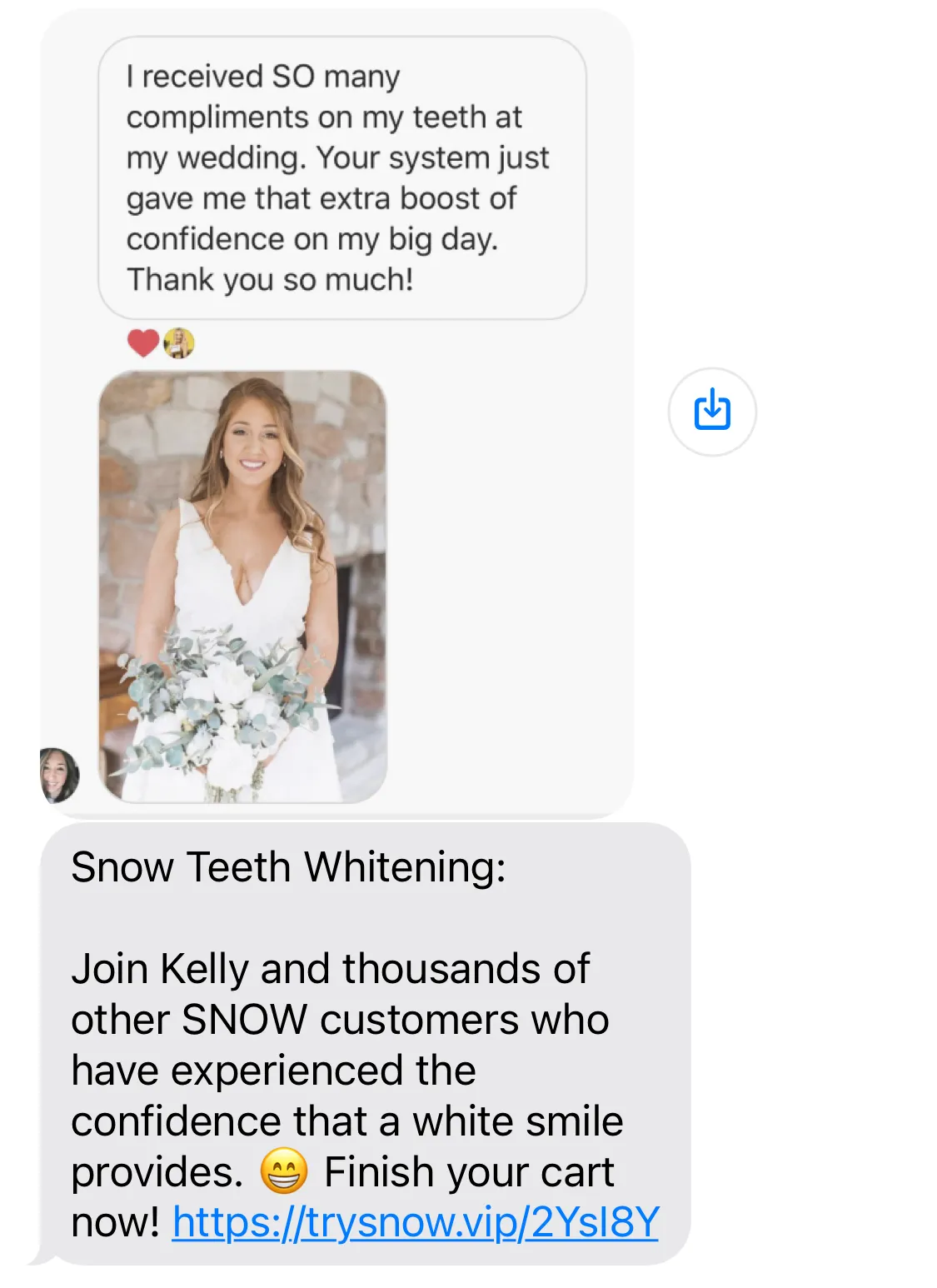
Optimizing Your Abandoned Cart Automation
As you build out your automation testing plans, your abandoned cart strategy should be at the top of your list. After all, you only get one chance per abandonment event, which makes it extra important to send the message you know has the best shot at converting.
In addition to tweaking messages based on purchase history and product—as we demonstrated with the examples in the previous section—you’ll want to nail down which offers work best for your audience (for those messages where you opt to provide an offer, that is).
This generalized abandoned cart automation from beauty brand Three Ships not only includes an offer for 10% off, but also adds urgency by letting subscribers know that the discount expires in only six hours.
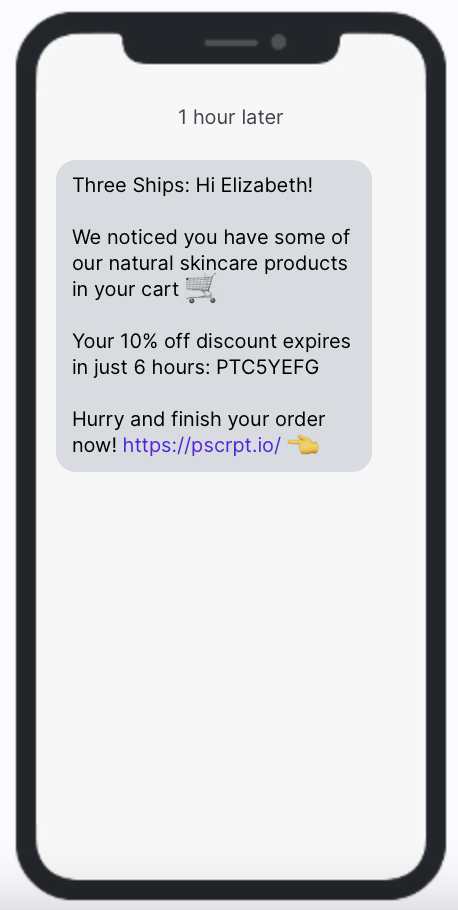
On the other hand, this product-specific abandoned cart offers a discount in the form of a dollar amount rather than a percentage. This is an excellent strategy to test, because in some cases “$15 off” might sound a lot more enticing than “15% off.”
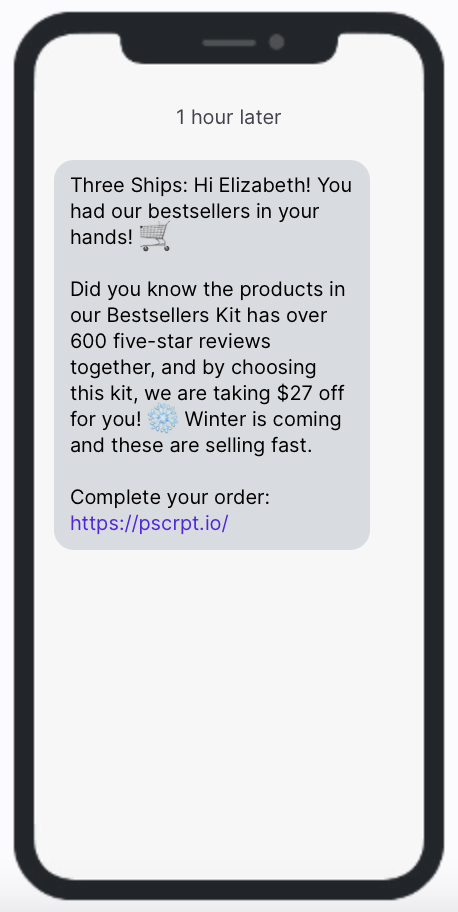
In the first version of the following abandoned cart automation for new customers, organic superfood brand Your Super offers a 10% discount.
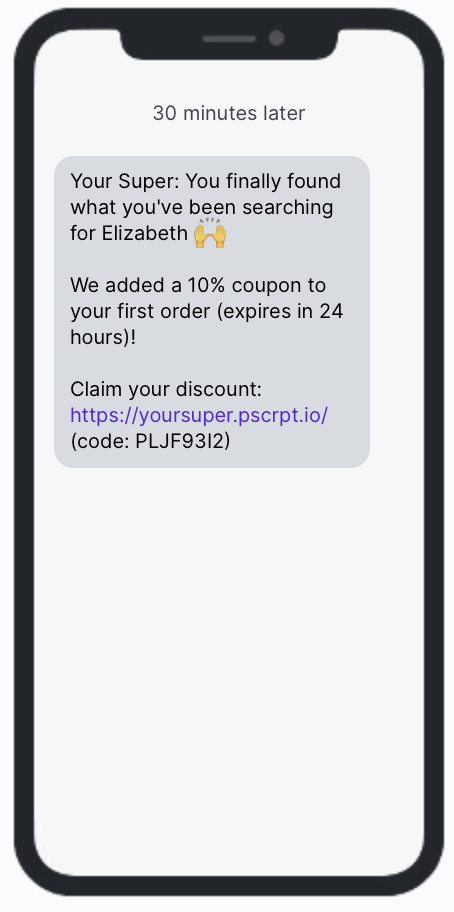
The second version features a potentially more enticing mystery offer.
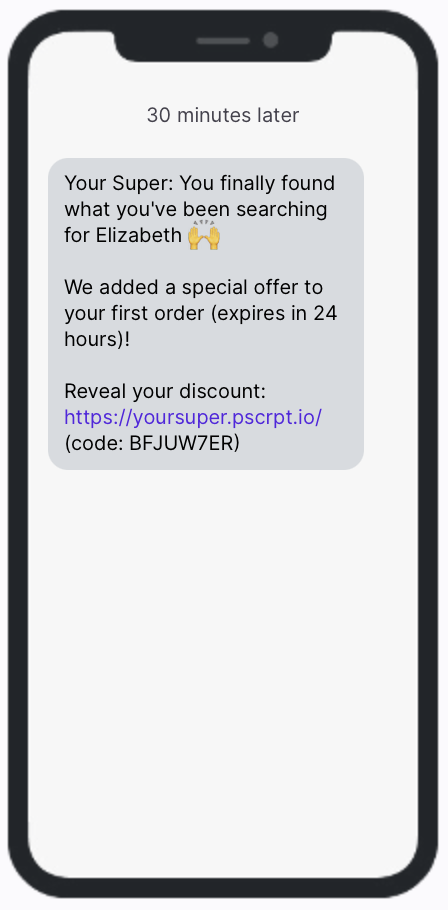
3. Browse Abandonment
Like abandoned carts, browse abandonment automations can be an effective way to nudge already-interested shoppers into taking action. The difference is that the recipients of this automation have merely looked at a particular product (or in some cases, placed it in their cart)—but they have not yet begun the checkout process, which indicates that they are earlier in the consideration stage. There’s also a chance that after viewing a product, they decided they don’t want or need it—or they’re a first-time visitor who needs a little extra incentive to come back and reconsider.
All of that is to say, it’s not as much of a slam dunk as an abandoned cart. But, browse abandonment automations still perform pretty dang well, generating the fourth-highest clickthrough rate and EPM out of the seven message types featured in our 2022 SMS Benchmarks Report.
Creating Your Browse Abandonment Automation
This automation is super easy to set up using an Automation Flow template in Postscript. We offer templates for both “product viewed” and “product added to cart” events. (If a shopper views multiple products without adding anything to their cart, you can feature either their first viewed or last viewed item in your abandonment message.)
Of course, simply reminding someone to come back and make a purchase might not be enough. This is where strategy and creativity come into play. Many brands offer an incentive—especially for first-time buyers.
Here’s a straightforward example from sauce and seasoning brand Fly By Jing. They add a bit of flair with their brand voice, reassure the shopper about the quality of the product, and throw in a 10% discount to sweeten—or should we say “spice up”—the deal.
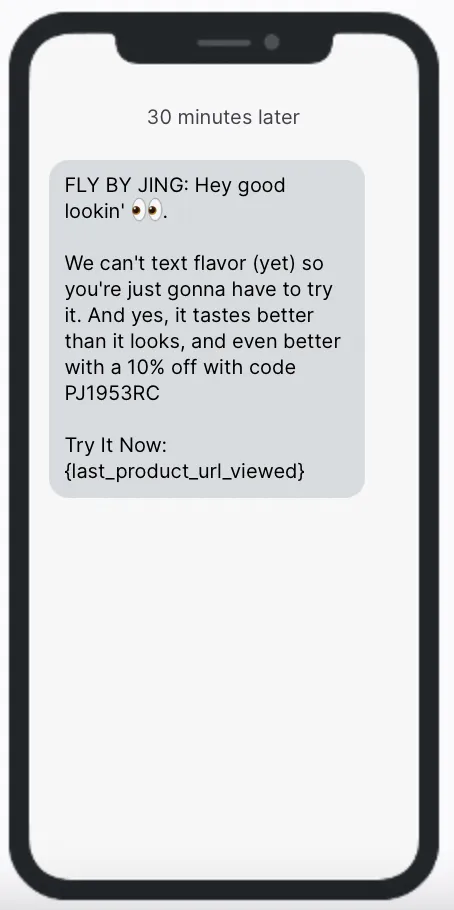
Ski brand J Skis uses their brand personality to make their browse abandonment feel less like a conversion play and more like a playful reminder from a friend. But, they still create some urgency by letting subscribers know inventory might not outlast demand.
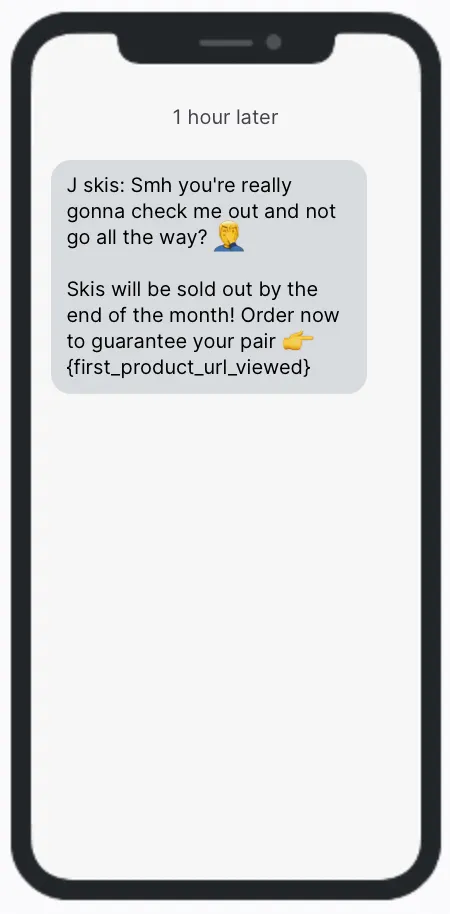
Other brands go the educational or social proof route—especially for subscribers who have not purchased before. The idea here is that the shopper might be skeptical about the product or unsure that it will meet their needs or standards.
Dog goggles brand Rex Specs takes this strategy one step further—and makes it feel more conversational—by inviting shoppers who are on the fence to reply with any questions they have. The hope is that once they have the right information, they’ll be ready to buy. (As a bonus, this could help you enhance your website content and product descriptions so potential customers can easily find the answers they’re looking for.)
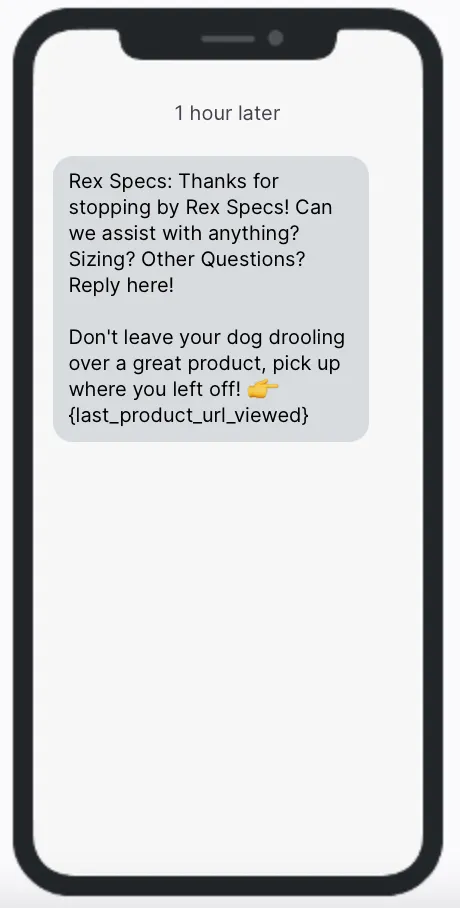
Optimizing Your Browse Abandonment Automation
Because browse abandonment messages are relatively high-converting, they are a great testing ground for identifying which types of offers your subscribers respond to best. And by applying your learnings, you can make this automation even more lucrative for your shop.
For example, you might test a standard 15% off discount against a “mystery” offer that will be revealed at checkout, like Homesick did with this browse abandonment automation.
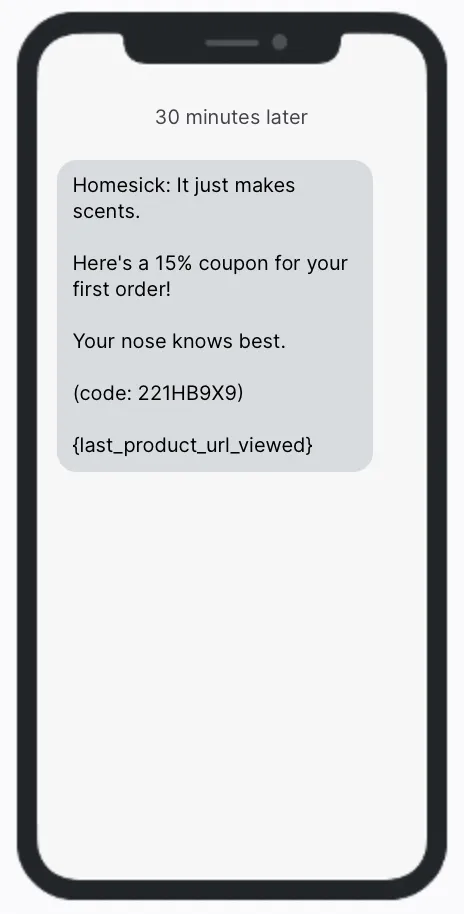
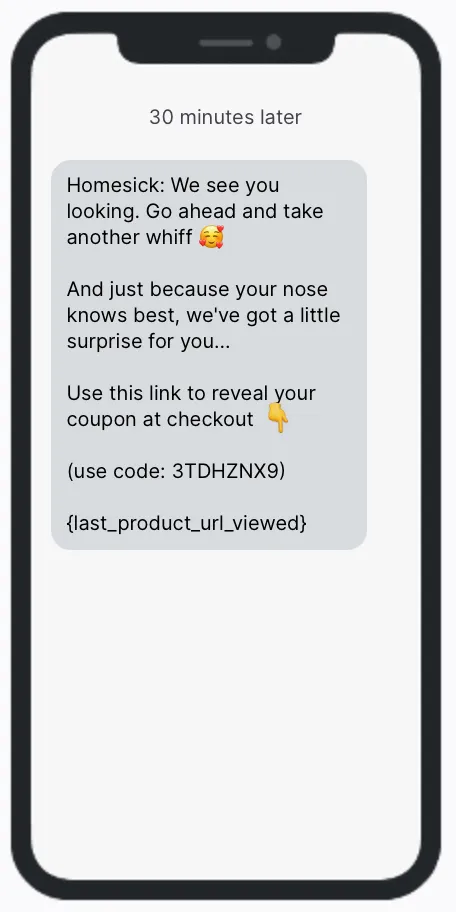
Similar to abandoned carts, you may want to test a discount percentage against a dollar amount. Here’s an example where Death Wish Coffee offers a $3 discount rather than the more commonly used 10% or 15% off.

You may also want to test your automation timing. While we definitely recommend sending this automation within 48 hours of the trigger event, you might play around with how long you wait to tap shoppers on the shoulder. Perhaps they’ll be more willing to purchase if their shopping session is still fresh in their minds—or maybe they need a little more time to “sleep on it.”
Another great strategy is creating special browse abandonment messages that align with big events or sales. For example, beauty and accessories brand Shop Miss A created this abandonment message for BFCM to further emphasize the urgency of purchasing before products sold out.
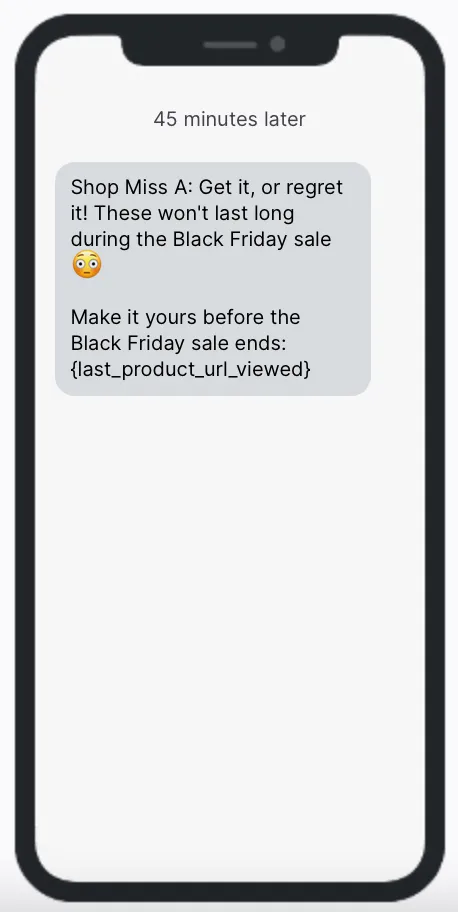
Speaking of Shop Miss A—they also ran this simple (but super smart) test to see whether featuring a browser’s first-viewed or last-viewed product had any impact on conversions.
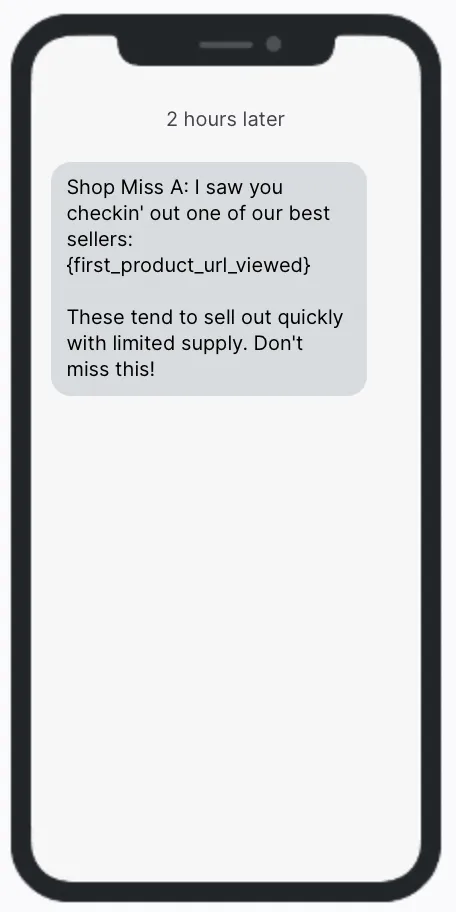
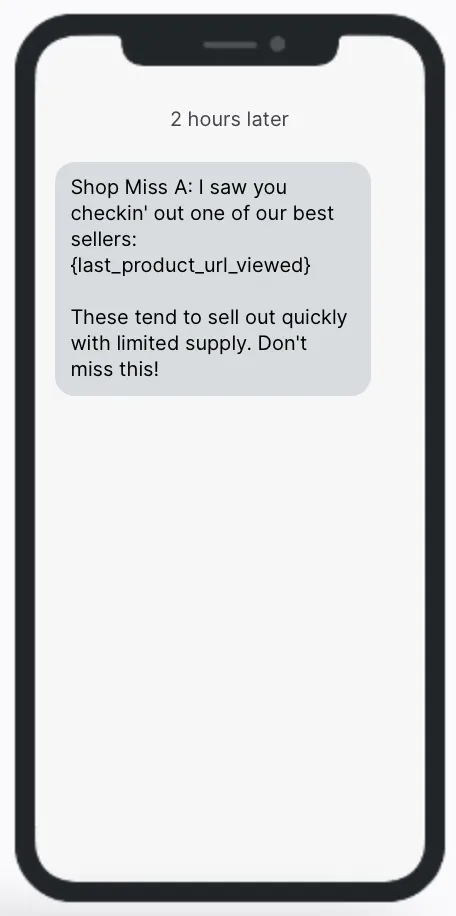
4. Post-Purchase
A customer’s journey doesn’t end once they make a purchase. At least, it shouldn’t.
Repeat buyers are the holy grail for ecommerce merchants. After all, it costs way less to drive a second, third, or fourth purchase (and beyond) than it does to nurture a customer through to their first order.
That’s why post-purchase automations are so crucial to your brand’s financial health. It’s a simple way to foster loyalty and increase the average lifetime value of each customer—which is key to the long-term success of your business.
Creating Your Post-Purchase Automation
Generally speaking, a post-purchase automation is triggered at some point after an order is created—and canceled when another checkout is started.
From there, you can use filters to send targeted messages to customers based on their order history. For example, you could target by product, item quantity, location, or total price—just to name a few.
There are tons of ways to use this automation type—from providing product education and recommendations to requesting customer feedback and reviews. In fact, we recommend setting up several different post-purchase automations optimized for different purposes (fostering engagement, improving satisfaction, driving additional sales, etc.). We’ll talk more about popular use cases in a bit.
To start, here’s a simple—yet thoughtful—example from oil and vinegar brand Brightland. This two-message series starts with a sincere thank-you and a handful of recipe suggestions incorporating the customer’s recently purchased product.
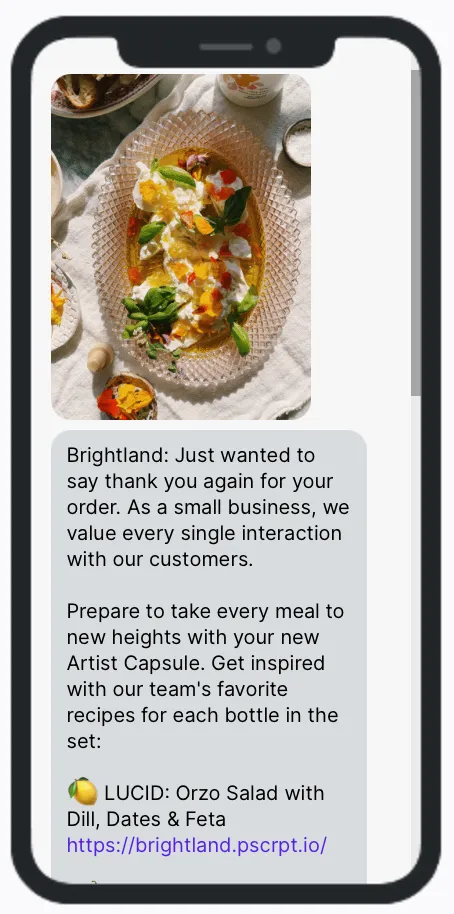

A few weeks later, the customer receives this follow-up with a new product recommendation and an invitation to reply with any questions.
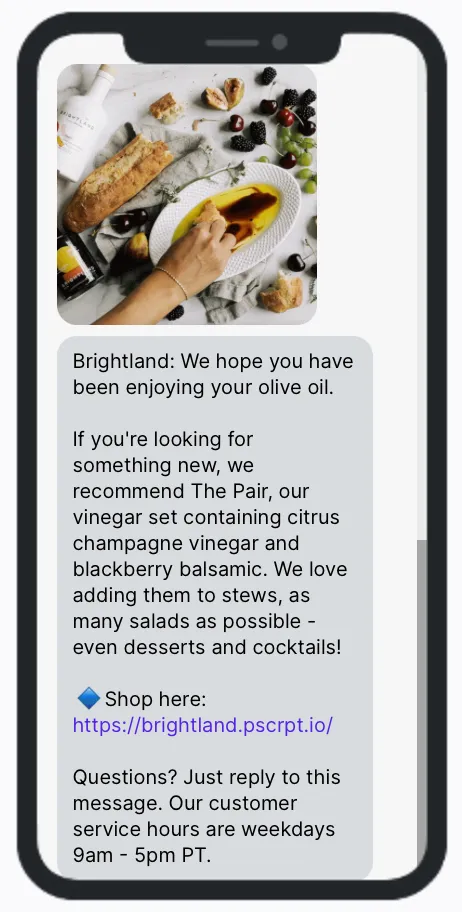
Beauty brand Three Ships sends this post-purchase automation to first-time customers shortly after they receive their order (meaning the automation trigger in Postscript is “Order Delivered” rather than “Order Created”).
The main focus of this three-message series is making sure new customers are using their products correctly and confidently—and offering assistance with any questions or issues they may have. The second message leverages keywords, which recipients can reply with to request even more product-specific information.
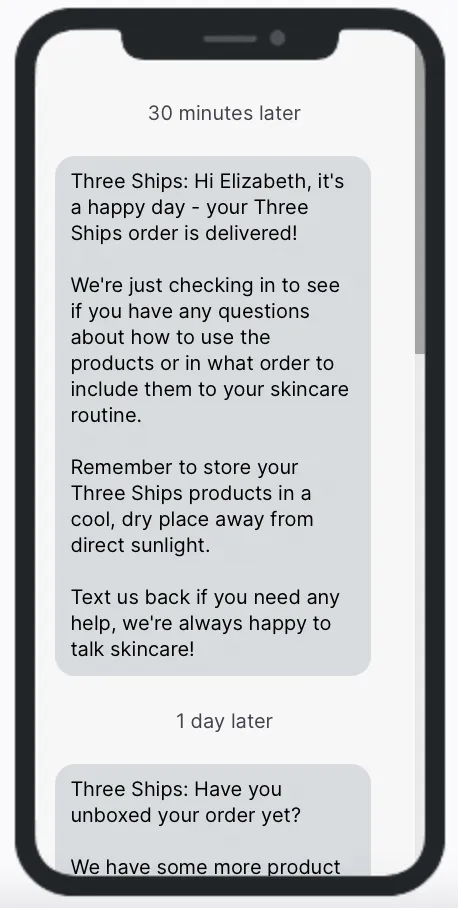
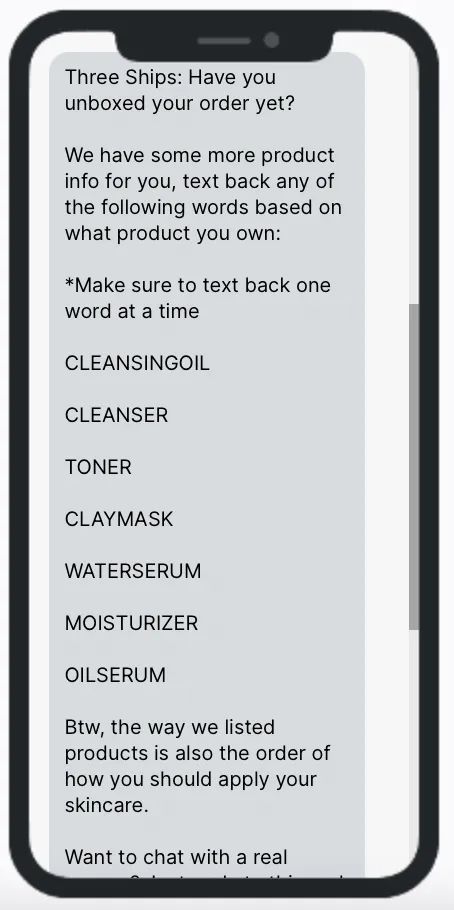

Okay, let’s run through some specific use cases for post-purchase messaging. While you don’t necessarily need to have every one of these in place for your brand, we’d recommend enabling the ones that best align with your products, audience, and goals.
Post-Purchase Loyalty
Rewards and loyalty programs are a popular—and effective—way to drive repeat purchases without tossing out coupon code after coupon code.
These programs typically have built-in benefits that entice customers to come back again and again—but newer customers might not know you offer these perks. So, use your post-purchase automation to tease your loyalty program and nudge customers toward taking the action necessary to access it—whether that’s completing additional orders or simply signing up.
This example from supplements brand Insane Labz lets customers know they only have to make one more purchase to unlock VIP benefits. To further incentivize purchase, they dangle a $20 discount.
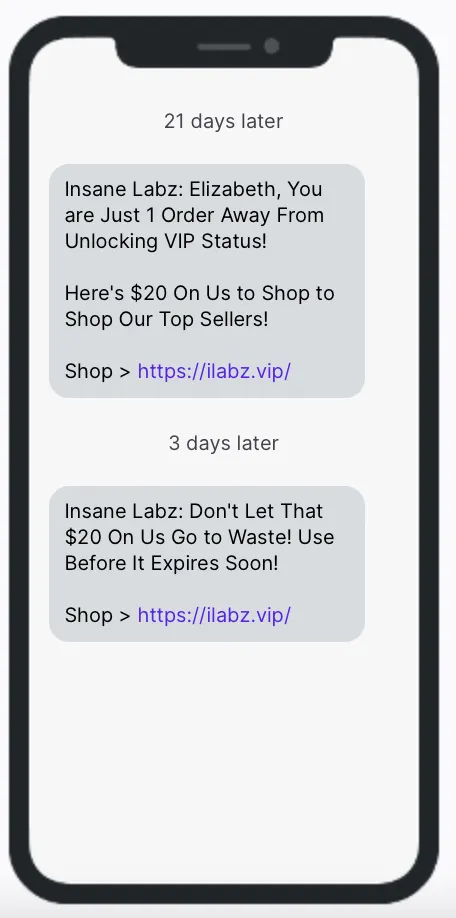
Once a customer does become a VIP or loyalty rewards member, keep the good vibes flowing with a congratulatory message celebrating their status and making them feel even more special. And of course, a discount never hurts. Here’s an example from edible cookie dough brand Doughp.
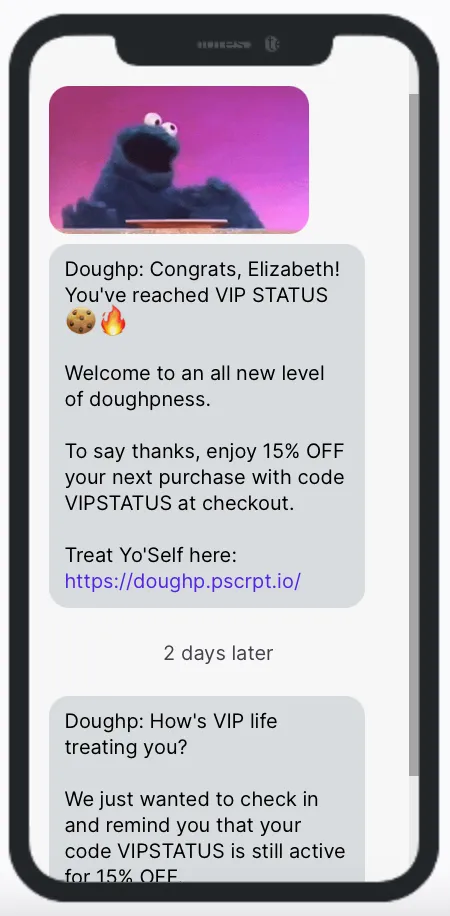
Post-Purchase Cross-Sell
This is one of the most common strategies for post-purchase automations. The idea is that if a customer liked the product they ordered, they’ll probably like…[fill in the blank]. If you have a lot of similar or complementary products that fall within the same price range, this is a great post-purchase automation play.
Technically, we already provided an example with the Brightland post-purchase flow shown above, but just for good measure, here’s one more they created for a different product.
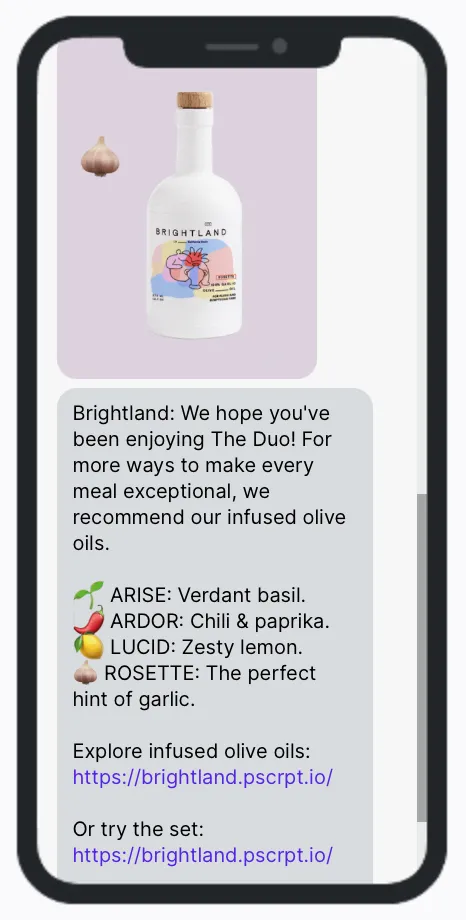
Watch band shop Braxley Bands weaves two subtle cross-sell pitches into their post-purchase flow, with the second message in the series reminding customers to wash their band—or simply replace it with a new one.

And then the third message in the series provides a tongue-in-cheek offer for “relationship advice” as well as one more plug for Braxley’s extensive catalog of band styles.
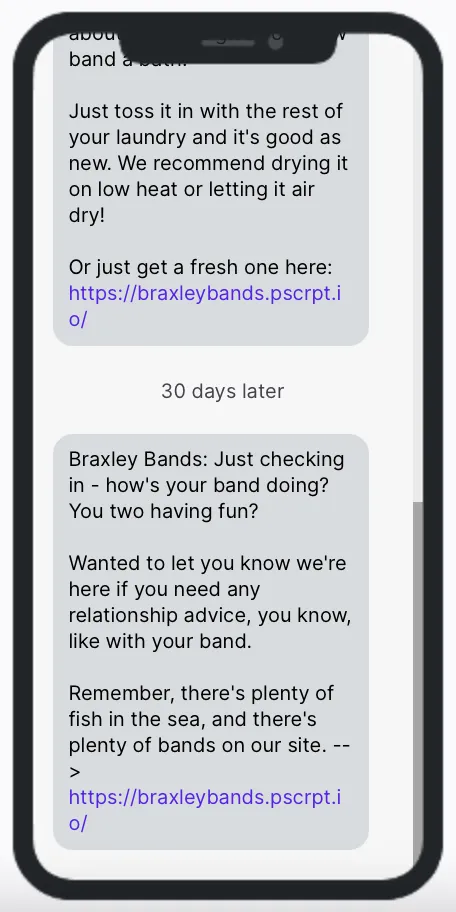
Nutrition brand Perfect Keto has created several versions of their cross-sell automation, swapping in different products based on what the customer has and has not purchased. Here’s the version recommending Keto Bars to those who have purchased Keto Collagen.
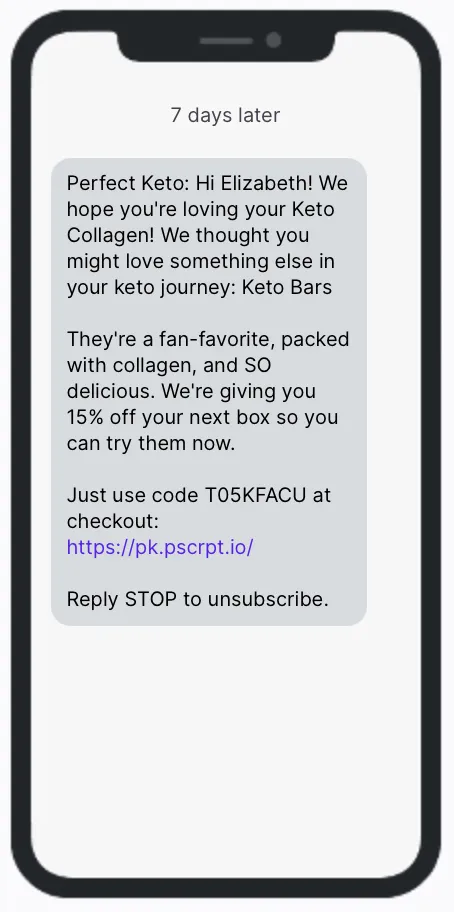
And here’s the reverse—recommending Keto Collagen to those who have purchased Keto Bars.
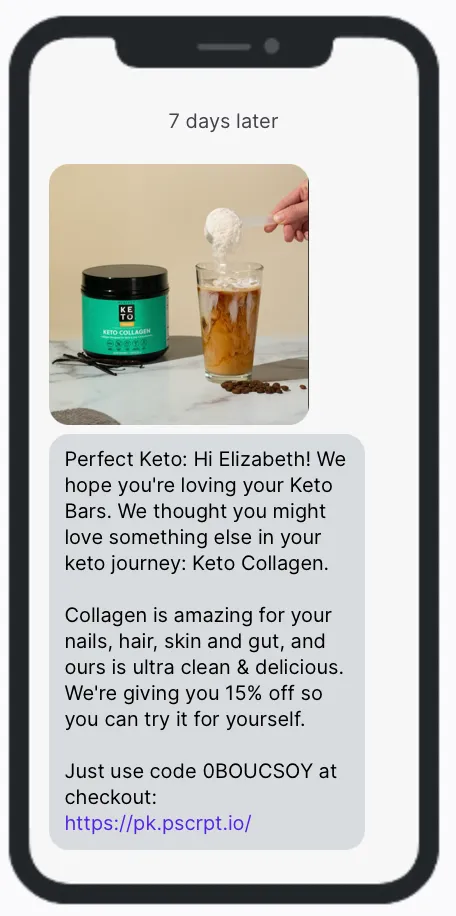
Post-Purchase Upsell
Upsell automations are meant to recommend products that are more expensive than the one(s) a customer has already purchased.
For example, a beauty brand might recommend a skincare bundle to customers who have purchased a single skincare item. Or, a leather goods brand could recommend a bag to someone who previously purchased a belt or a wallet.
Here’s an example from loungewear brand Jambys. This automation goes to customers who have purchased a t-shirt but have not purchased bottoms or a hoodie. The first message recommends these other, higher-priced products—and the second message focuses specifically on the brand’s highly rated shorts. Mentioning their “77-day guarantee” ups the trust factor even more.
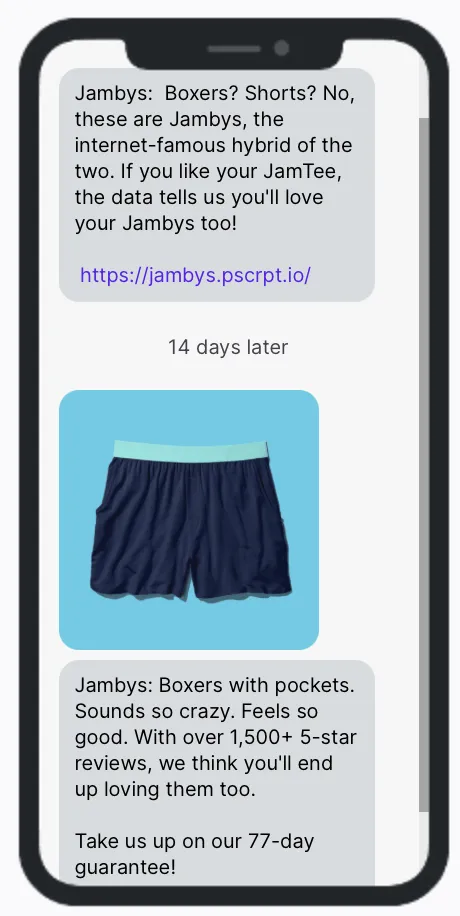
This example from superfoods brand Your Super suggests a higher-priced product that will enhance the customer’s experience with the product they already bought. (They had us at “extra foamy.”)
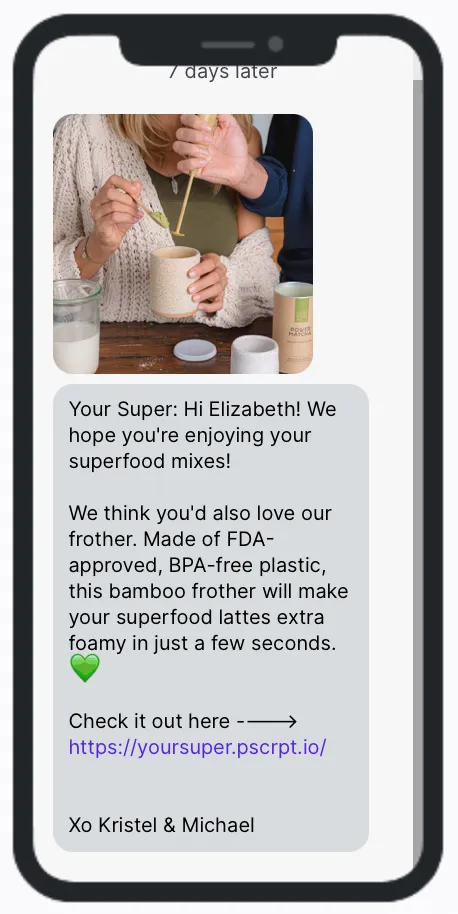
If your brand offers subscriptions, you may want to consider adding a post-purchase flow to “upsell” signing up. Here’s a simple example from natural supplements brand Apothékary.
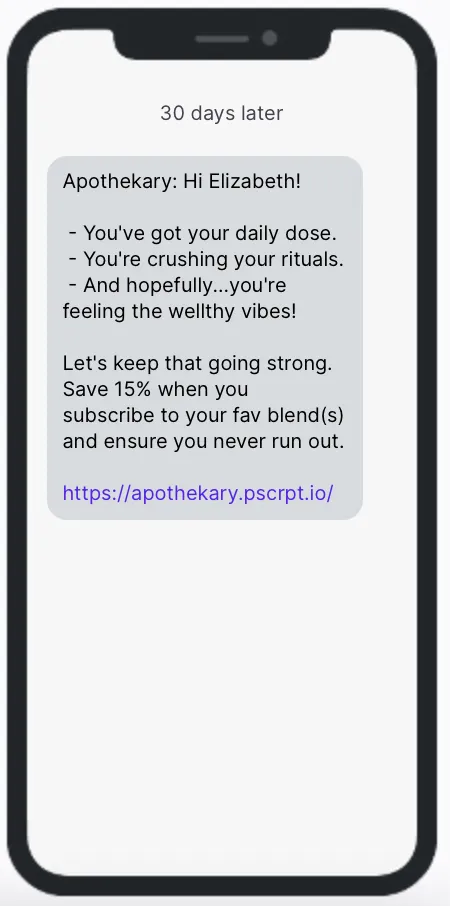
And here’s one from natural deodorant brand Native.
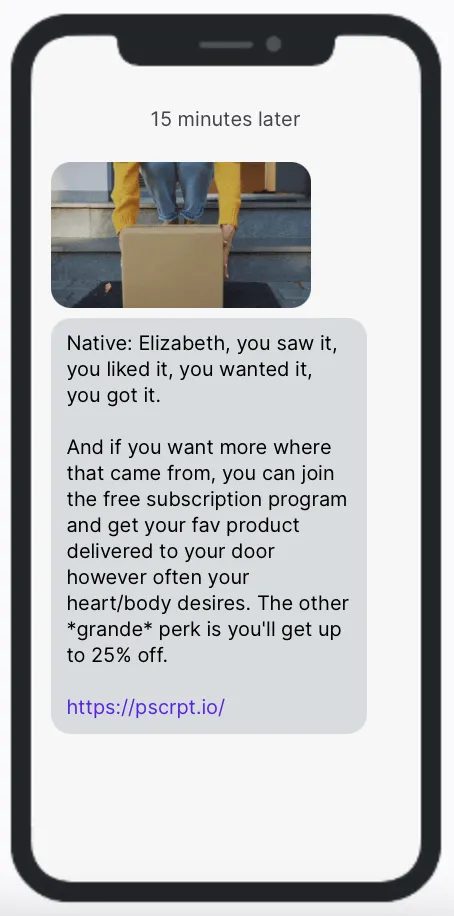
Post-Purchase Review Request
Reviews are absolutely crucial to the success of any ecommerce business. It’s the digital equivalent to word-of-mouth, and many online shoppers make purchase decisions based solely on the opinions of past customers. In fact, according to Shopify, “93% of new customers actively seek out reviews before they buy,” and they are “63% more likely to trust and buy from a company with good reviews.”
As an inherently conversational channel, SMS is a fantastic vehicle for review requests. It’s so easy for folks to tap your review link and type a few (hopefully positive) words right then and there.
The best time to ask a customer for a review is when their great experience with your product is still fresh in their mind. So, build a review request message into your post-purchase automation flow—or create specific review request flows for specific products (like those that could use a boost in reviews).
Here’s an example from food brand NuSkool Snacks. This is the second message in their five-message post-purchase flow (the first message confirms shipment).
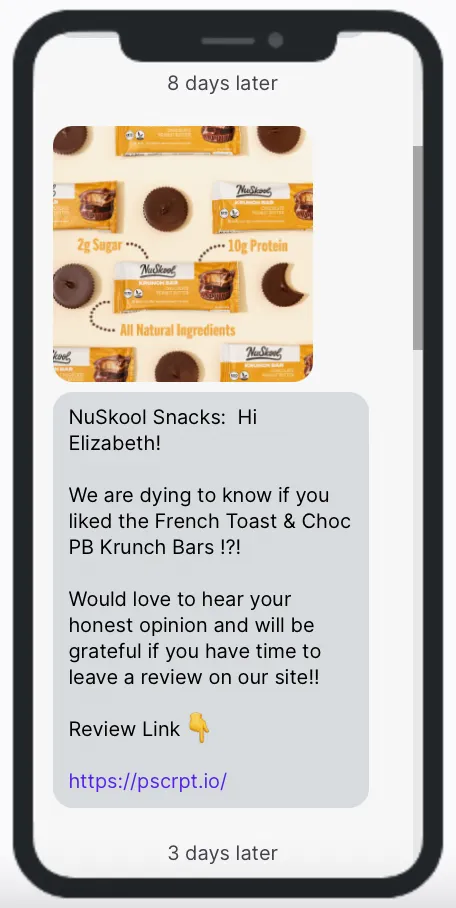
Nutrition brand Perfect Keto adds a personal touch to this review request, which comes in the middle of their three-message post-purchase flow for first-time customers. We especially love the last line assuring the customer that their review will be read.
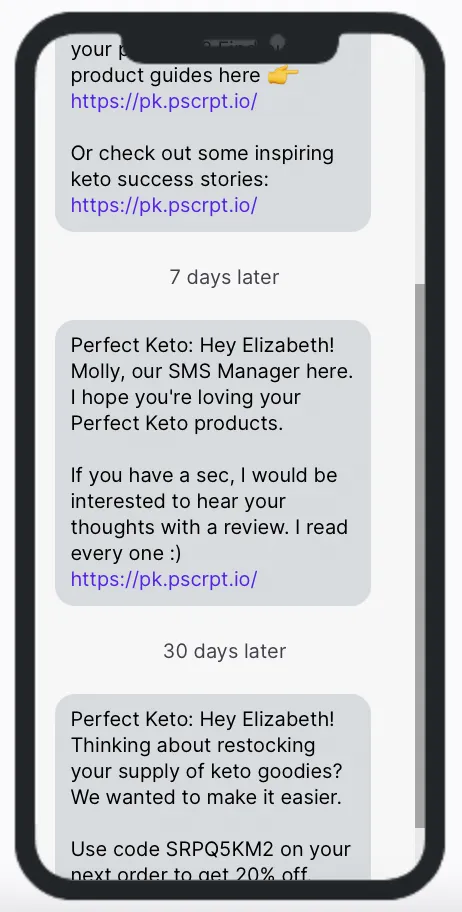
Post-Purchase UGC Request
Similar to reviews, user-generated content (UGC) helps build trust with potential customers who have yet to try your products. It’s also a pretty effective promotional strategy. According to Forbes, “Ads based on user-generated content receive four times higher click-through rates and a 50% drop in cost-per-click compared to average ads.” And on the organic side, “when users create and share content on social media channels, they get 28% higher engagement compared to standard company posts.”
Clearly, social proof is a powerful sales tool—particularly in ecommerce—and your post-purchase automation is a great place to ask for it.
Braxley Bands comes right out of the gate with their UGC request. Here’s the first message in their three-message post-purchase flow.
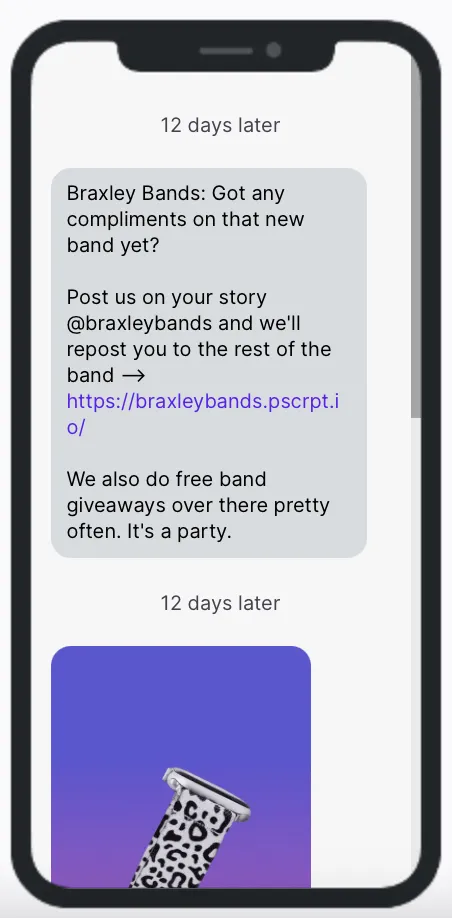
Post-Purchase Product Feedback
Public-facing reviews are obviously great, but there’s also value in more candid (and yes, sometimes critical) feedback. It can help you improve your products or clarify your educational materials to help customers achieve the intended experience or outcome.
Of course, you’d rather receive that sort of feedback privately—which makes two-way SMS the perfect place to request it.
Here’s another example from NuSkool Snacks. This is the final message in the five-message post-purchase series referenced above—coming after the review request and a couple of discount offers.
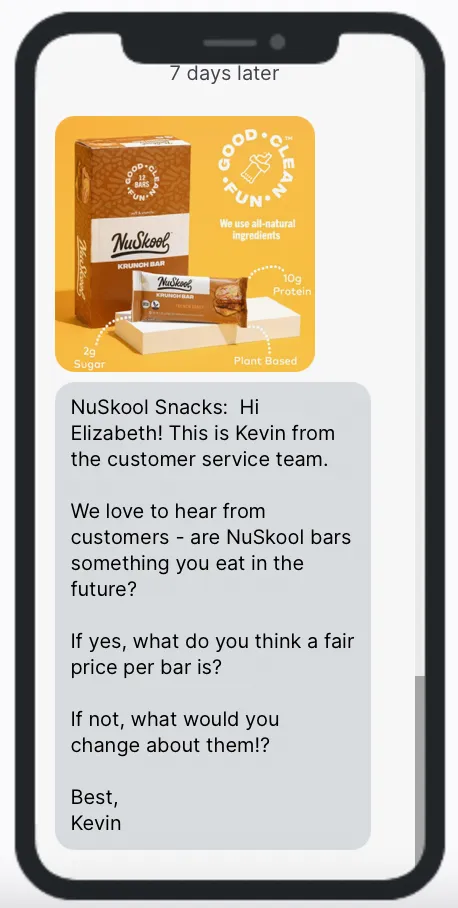
Having the message come from a real employee adds to the conversational vibe. Plus, we’re betting folks will feel more inclined to help out a real person.
Just be sure to respond to any feedback you receive—positive or negative. In fact, responding thoughtfully to any criticism you get back could help you win back the business of a customer who otherwise wouldn’t have purchased from you again.
Optimizing Your Post-Purchase Automation
As you can tell from the previous section, there are a lot of different directions you can go with your post-purchase messaging—which means there are a lot of variables you can test. So, rather than try to cover every single one, we’ll pose some questions to get you thinking about the tests that might be most valuable for your specific brand, audience, and products.
If you send multiple messages as part of a single post-purchase flow, have you tested the order of the messages?
Should the first message include a discount for the customer’s next order—or should product education be the top priority immediately following purchase? Should you ask for a review before or after you’ve offered an additional discount?
There are so many ways to structure multi-message flows, and it might be worth testing which approach yields the most engagement or revenue—depending on your goals for the automation.
If you get a lot of reorders, have you nailed down the timing and content of your reminders?
This is a great question to ask yourself if you sell consumables. Even if you have a pretty good idea of how long it will take a customer to use up their product, there’s the question of when the urgency to repurchase will be highest. Two weeks before they run out? One week?
Sounds like an opportunity for an A/B test!
If you really want to level-up your reorder strategy, consider integrating your SMS platform with a reorder platform. Postscript has a fantastic integration with Repeat, which enables brands to automatically deploy reorder reminder texts when customers are the most likely to buy again. (Check out this blog post for more tips on optimizing your reorder reminders.)
Here’s an example of a text from soda brand OLIPOP that leverages the Postscript + Repeat integration. (Notice the personalized shopping cart—another benefit of using this integration!)
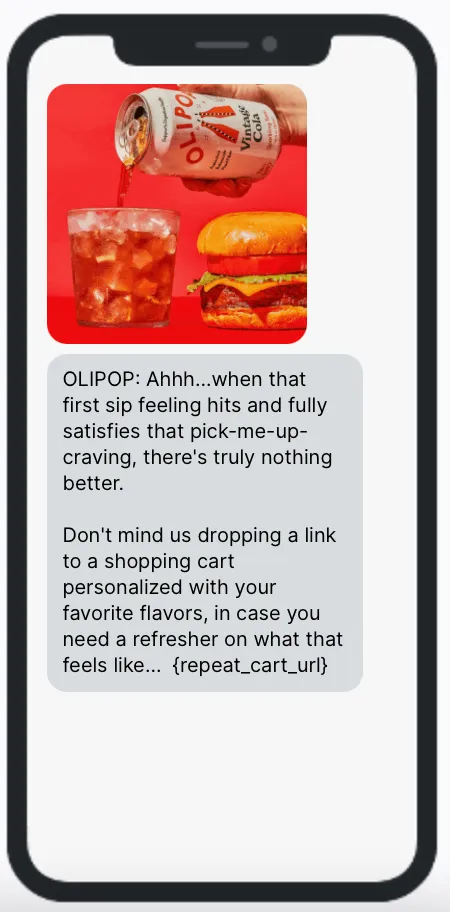
Another way to potentially optimize these sorts of reminders is adding an image of an empty or half-empty container, like hydration brand Hydrant did here.
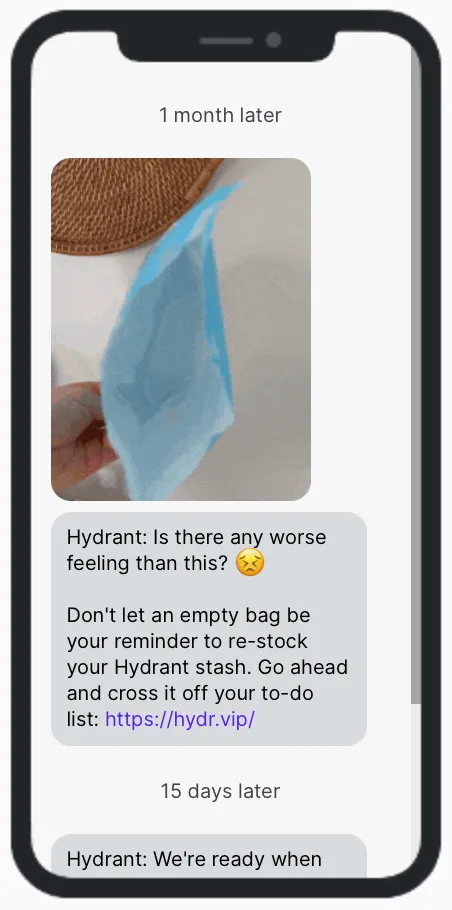
If you’re leaning heavily into upsell and cross-sell automations, does including a product photo or GIF impact conversion rates?
Take a second look at our Perfect Keto cross-sell examples above. As you can see, one automation contains a product photo, while the other is text only.
Theoretically, they—or any brand, including yours!—could run a photo/no-photo test for every single upsell and cross-sell automation. The fact is, it’s more expensive to send an MMS than an SMS—so this is a great way to validate that the returns are worth the extra spend.
Do you know which upsell and cross-sell pairings drive the most engagement and sales?
Also on the topic of purchase-based product recommendations, it may be worth testing different combinations of products to see which ones work best. You may be surprised by the related preferences you discover!
Is there an opportunity to create an automation based on engagement with other automations?
This probably sounds a bit like automation inception, but it might be worth trying out a follow-up message for customers who engaged with your post-purchase messaging—but didn’t take action on it.
Here’s an example from Jambys. This automation goes to subscribers who clicked on any of several upsell post-purchase automations—but did not convert.
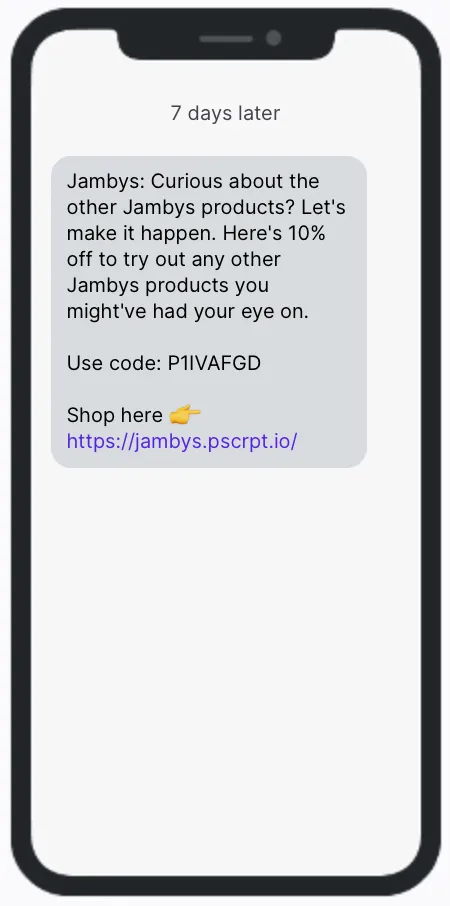
Certain integrations allow you to leverage even more granular events and triggers to send more contextual follow-up messages. For example, through Postscript’s integration with Junip, Homesick is able to send this automation to subscribers who end up leaving a review.
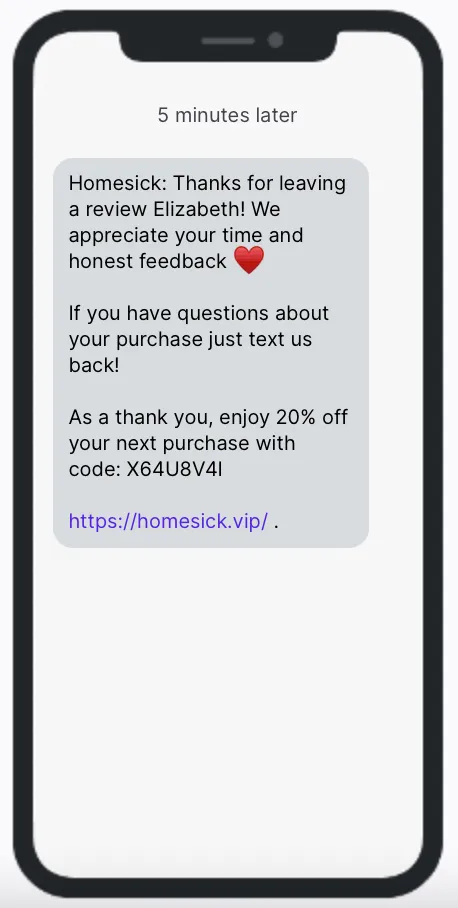
Could you leverage an integration to drive more revenue through text?
Continuing on the topic of integrations, some platforms may integrate in a way that allows subscribers to buy products via text. Postscript’s integration with Recharge, for example, allows subscription customers to add products onto upcoming recurring orders.
Here’s an example of this reply-to-buy use case in action from Apothékary.
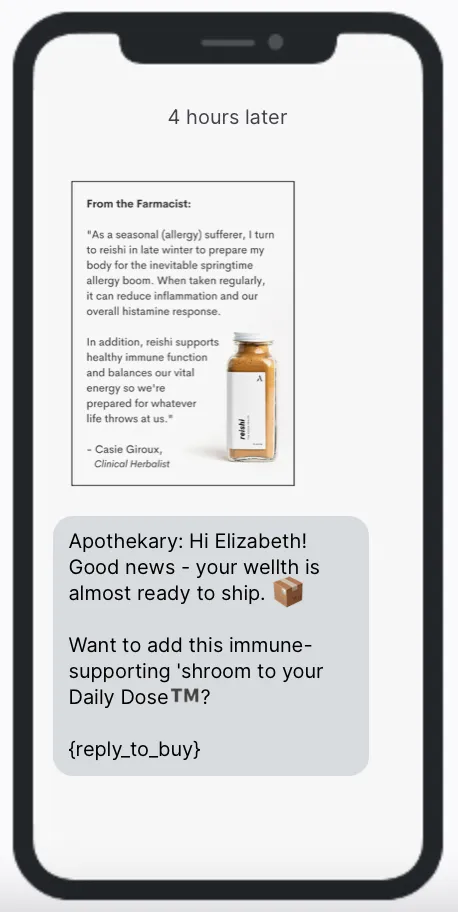
5. Winback
Every brand has past customers who haven’t purchased from them in a good long while. But the important thing is that they did buy—which means getting them to convert again will be much easier than capturing an initial conversion from a brand-new customer.
If you have SMS subscribers who fall into this bucket, then you are sitting on a potential gold mine, because driving engagement with them via text is going to be way more cost efficient than reaching them through third-party advertising channels.
At the most basic level, customer winback automations target past buyers who haven’t completed an order for some defined amount of time—commonly 30, 60, or 90 days. These messages often include an incentive to come back and purchase again (e.g., discount, free shipping, free gift, etc.). In some cases, though, notifying lapsed customers about new products or upcoming promotions might be enough to get them back in the door.
Creating Your Winback Automation
In Postscript, you can set up a winback automation to fire at any point after an order is created. You can also add filters to create messages targeted to buyers of certain products or price points.
We’ve even created a winback automation flow template you can select and customize within Flow Builder!
Here’s a solid example of an all-purpose winback automation from health and beauty brand Obvi. Delivered after 45 days of no purchases, it teases new products, provides a 15% discount, and links to a collection of bestsellers.
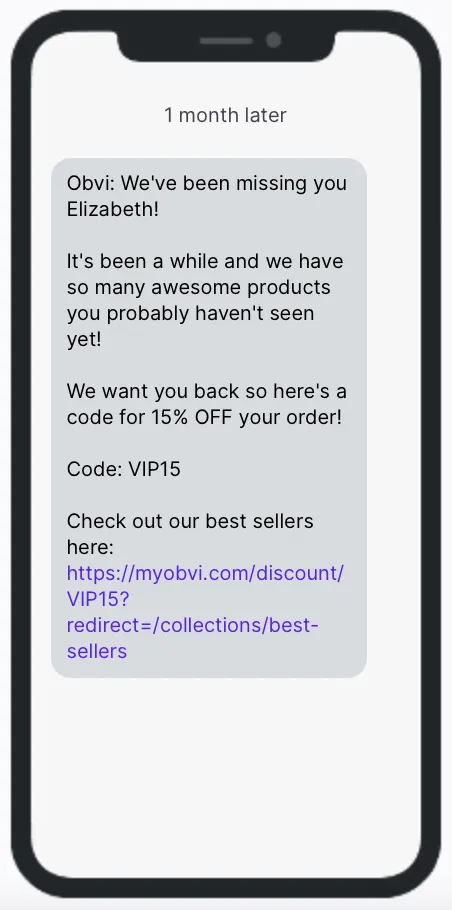
Edible cookie dough brand Doughp adds some emoji flair to their two-message winback flow offering a sweet 15% discount to come back and snack.
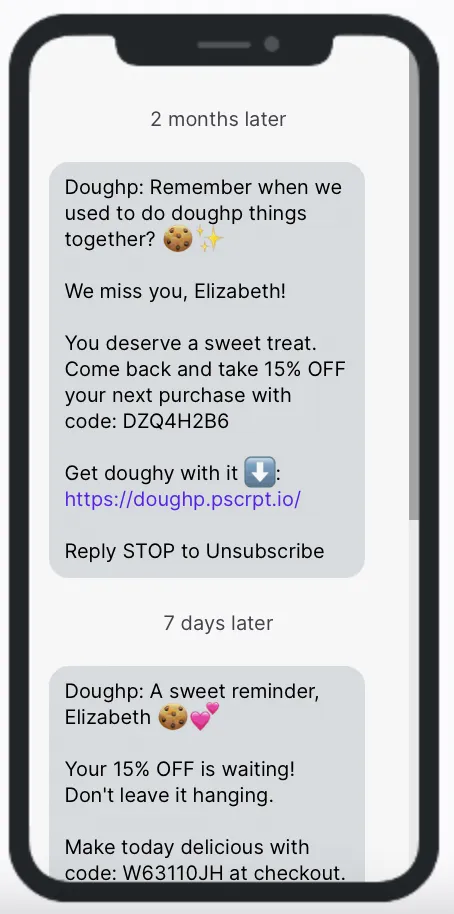
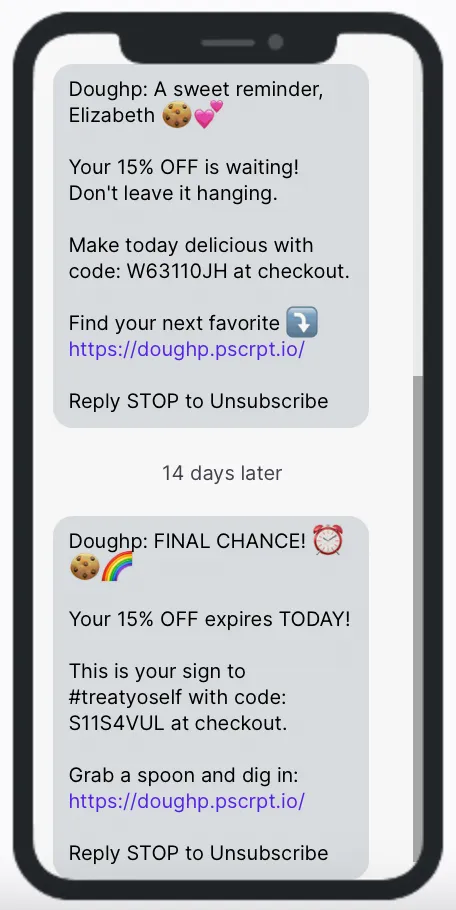
Optimizing Your Winback Automation
To fine-tune your winback strategy, try running A/B tests with varying offers and time windows (30 days later, 60 days later, etc.) to see what performs best. Optimal timing will be heavily dependent on the types of products you sell and whether it makes sense for a customer to use multiple products at the same time.
A past customer of beauty brand Kopari, for example, could probably get value out of several different products simultaneously—and that is reflected in the language of their winback teasing recently launched items.
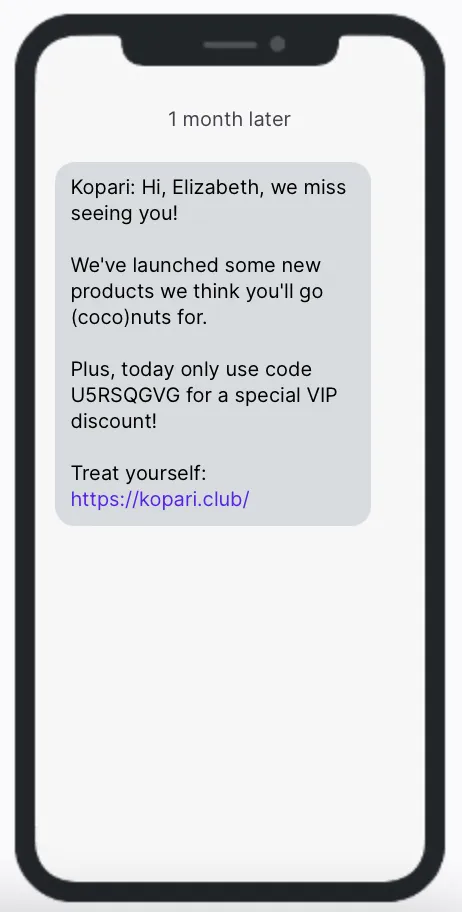
Or, try segmenting winbacks based on the number of times a past customer has purchased from you. The more familiar they are with your brand and products, the more casual and friendly you can make the tone of your messages.
For example, Death Wish Coffee sends this winback to customers who have purchased once before.
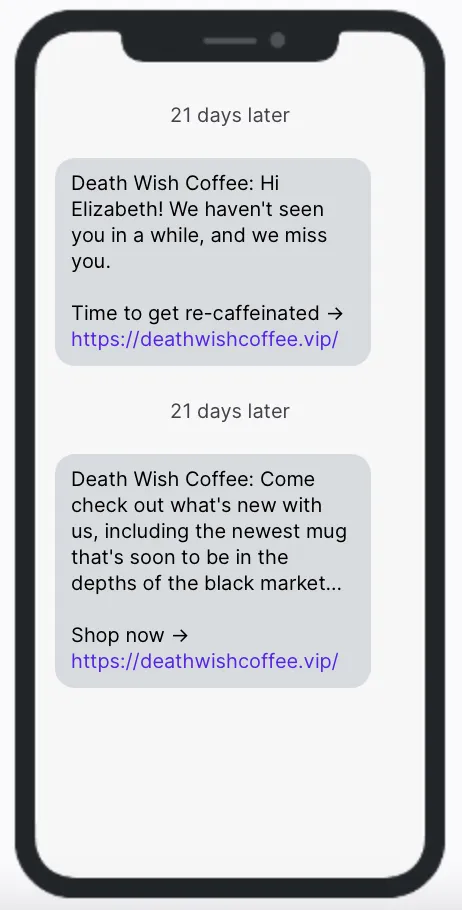
But their winback message to customers who have purchased twice is a little more cheeky. It also offers a 10% discount as a way to get a high-value repeat buyer back in the door.
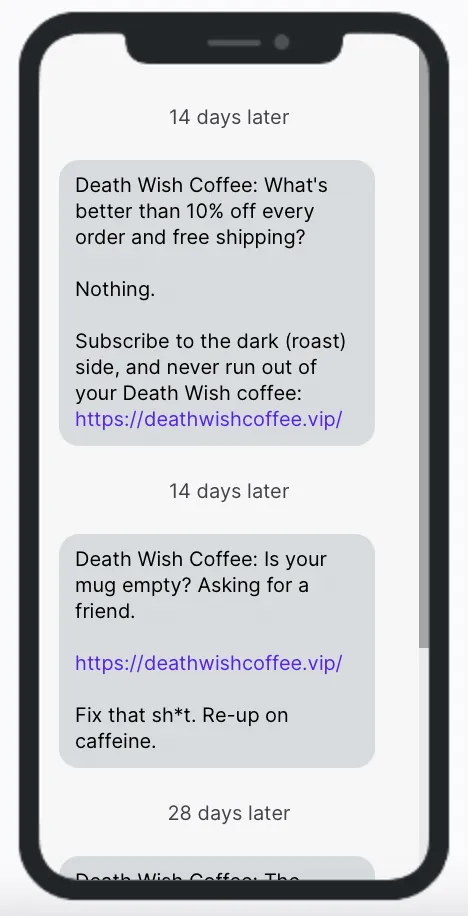
This brings up another strategy worth testing: discount versus no discount. Build a two-message flow where the first message focuses more on your value props or new arrivals, and the second offers a discount. If a subscriber converts on the first message, you can set the automation to cancel the second message. And if you find that the vast majority of recipients convert on the discount message, remove the first message and move forward with the discount winback only.
If you offer a subscription option, create a winback specifically for customers who cancel. Here’s an example skin and body care brand Blume sends out of Postscript by using their ReCharge integration.
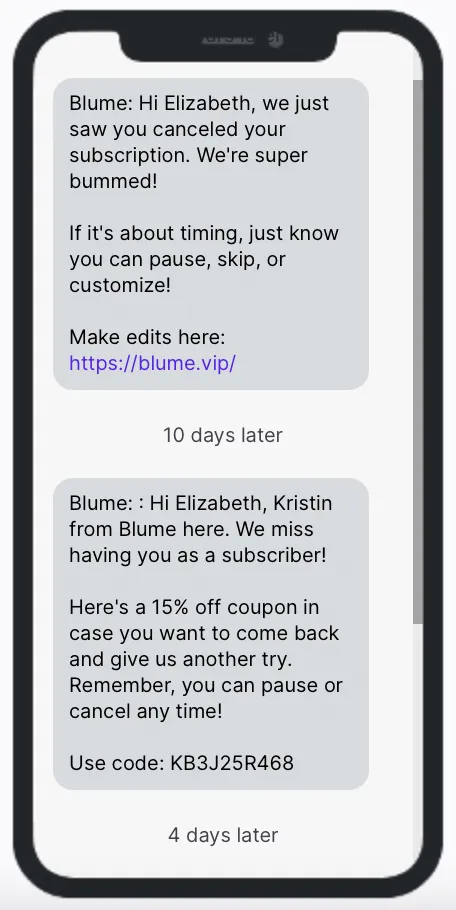
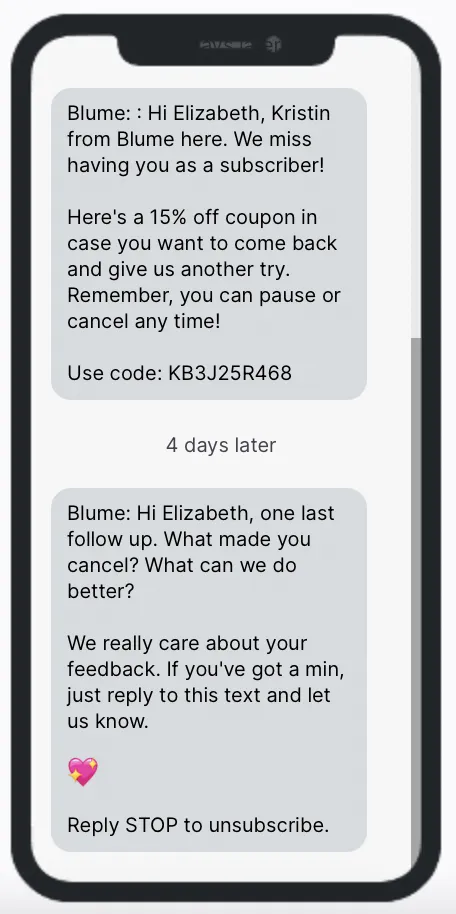
We especially love the third message asking the customer what made them cancel and how the brand can better meet their needs in the future. If you can’t win the customer back, you can at least try to learn something from losing them!
On the creative side, try testing MMS versus SMS. Here, sauce and seasoning brand Fly By Jing goes the MMS route with a fun GIF to match their playful tone.
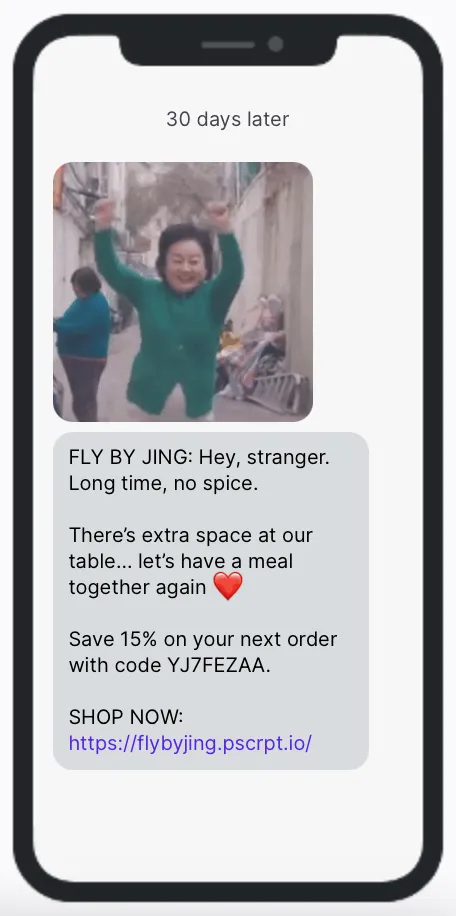
6. No Order
You put time, effort, and money into growing your SMS subscriber list. Unfortunately, you won’t get a return on every single opt-in you collect—but you can put measures in place to help tip the scales in your favor.
One such strategy is a new subscriber, no order automation. This flow goes to new subscribers who don’t purchase within a certain amount of time after opting in—typically 15 to 45 days. It often offers a discount or other incentive to help get a recent subscriber over the finish line.
Creating Your No Order Automation
You can easily set up this automation in Postscript using the “Subscriber Created” trigger and then adding the time delay of your choice (e.g., 30 days). You can also use our “Subscribed, No Orders in First 30 Days” automation template within Flow Builder.
From there, you may want to filter out subscribers who are currently in other conversion-focused automations—like browse abandonment or cart abandonment.
Here’s a simple example that men’s soap brand Dr. Squatch sends to new subscribers who haven’t purchased within 30 days of opting in.
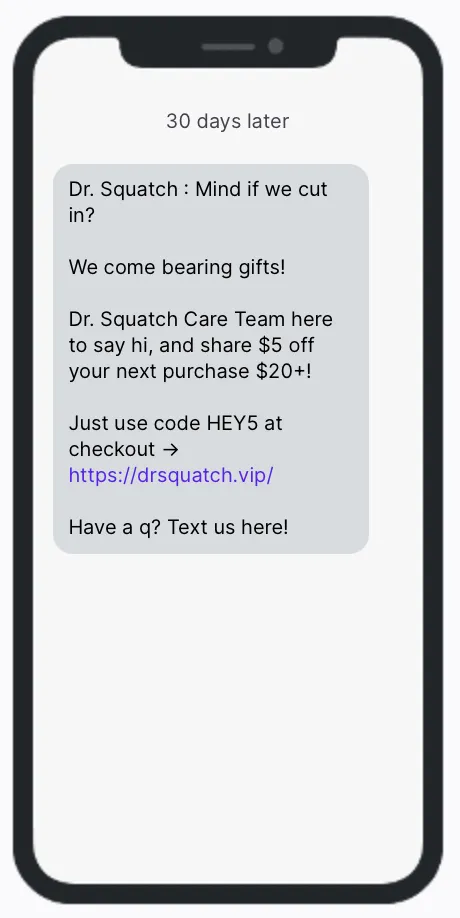
Optimizing Your No Order Automation
While there is some room to test timing, it’s important to consider that the vast majority of unsubscribes happen within the first 30 days. So, there is some urgency around pushing new subscribers to purchase sooner rather than later.
Your timing will be dependent on the other messaging subscribers receive after joining your list. Obviously you don’t want to fire off a no-order automation when a new subscriber is still going through your welcome series. But if you wait too long, you risk having the subscriber churn out of your list before you have a chance to send this message.
You may also want to try adding an image or GIF to this automation to see if that affects performance, like health and beauty brand Obvi did here.
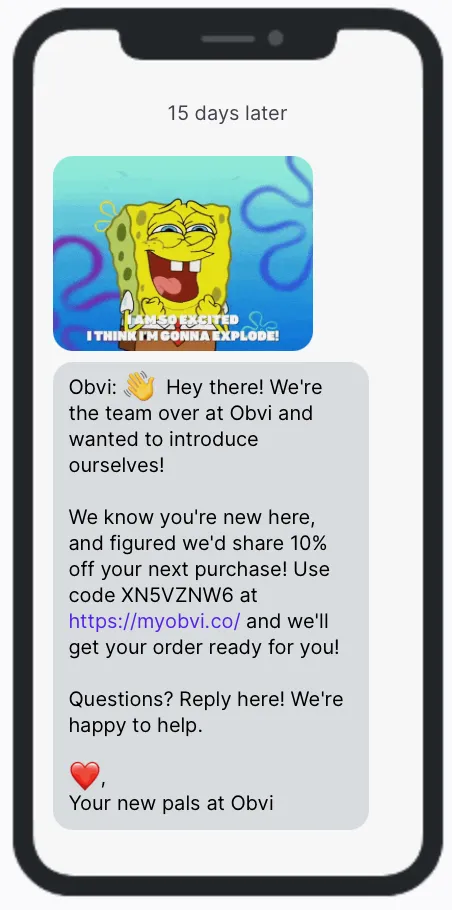
They also make this text feel very personal by offering their team’s help with answering any questions.
Bidet brand TUSHY keeps things light with their signature brand voice and an eye-catching GIF—making this one of their top-performing automations. Never underestimate the power of a little bathroom humor (when it aligns with your brand, of course).
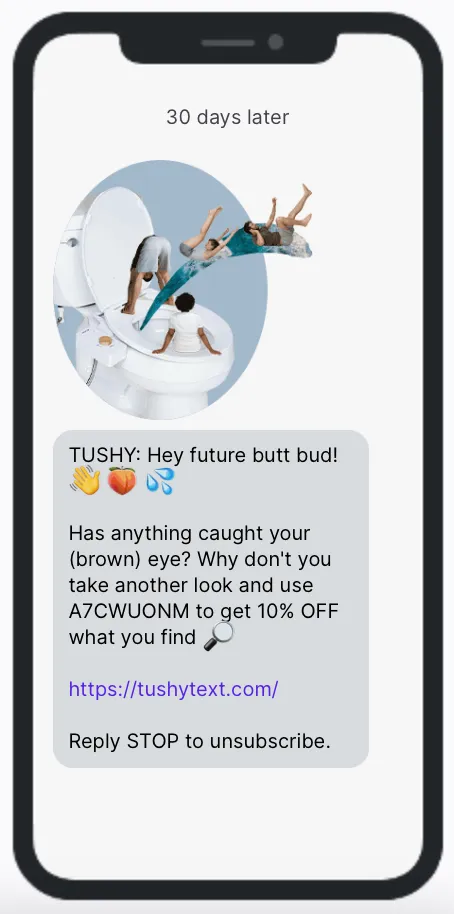
Another advanced strategy when creating this automation is thinking about what—beyond cost—might be holding subscribers back from making a purchase. Zero-waste toothpaste brand Bite understands that while potential customers have shown interest in their sustainable alternative to an everyday routine, they may be hesitant to give it a whirl.
So, in addition to their first no-order message—which takes a price-focused approach—they send a follow-up highlighting the thousands of five-star reviews they’ve received from existing customers. Both of these messages together go a long way toward reducing the perceived risk of trying Bite’s product.

Finally, while pet treat brand Natural Dog’s no-discount approach is a bit unconventional for this automation type, we applaud them for trying something outside of the box. The idea here is to spark engagement from a cohort that has been unresponsive thus far—and then serve up a recommendation (or other follow-up automations) that are more targeted to their specific needs. Definitely a strategy worth testing—especially as subscriber inboxes become more cluttered with a lot of similar-sounding messages.
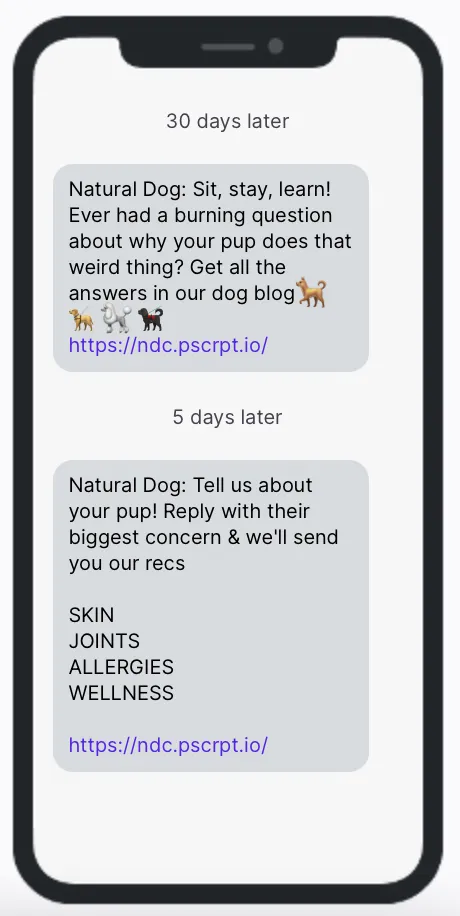
Here’s an example of an automated response the subscriber would receive after replying with one of the keywords (in this case, “JOINTS”).
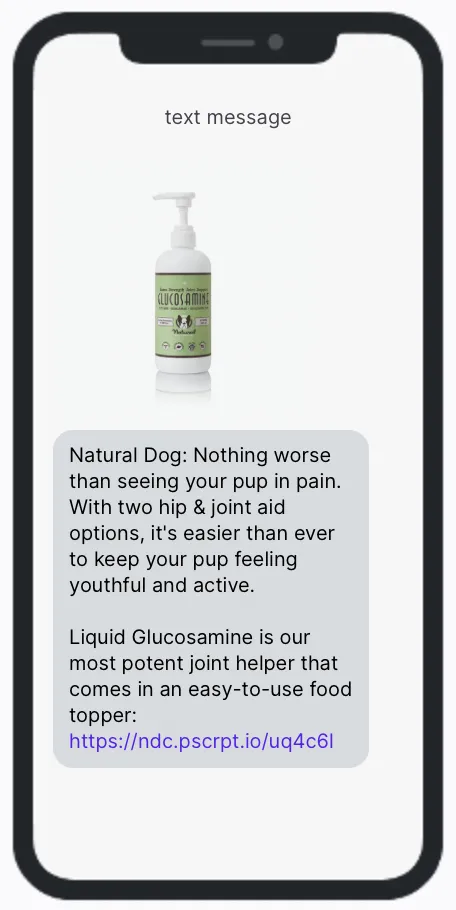
7. Back in Stock
You may already send back in stock campaigns when popular items are replenished, but a back in stock automation allows you to instantly notify shoppers who were interested in purchasing a specific item—but discovered it was unavailable.
Postscript’s Back in Stock feature allows shoppers to sign up for restock notifications directly from the product page of an out-of-stock item—making it a great way to collect new opt-ins and drive revenue from existing customers (not to mention reclaim revenue you otherwise might have lost). Plus, it helps turn a potentially negative experience into a positive one.
As we explained here, this automation is especially useful with the current supply chain environment, which has made it difficult for many brands to maintain stable and predictable inventory levels.
Creating Your Back in Stock Automation
Setting up this automation in Postscript may require a few extra steps depending on your shop’s Shopify theme. You’ll either add an opt-in hyperlink directly below the “Sold Out” button or insert a banner that opens a special opt-in popup—which you can customize in the Popups section of Postscript.
Here’s a banner example from can cooler brand Frost Buddy, where the banner appears in the bottom-right area of the product page.
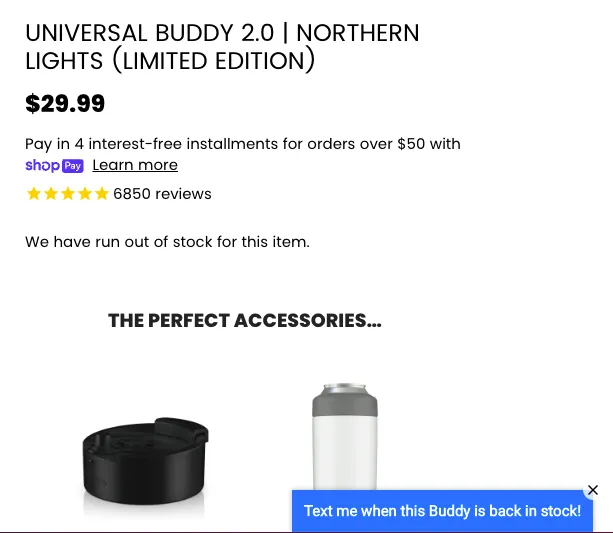
When a shopper clicks on the banner, this popup opens. They can then input their number and sign up for a restock notification.
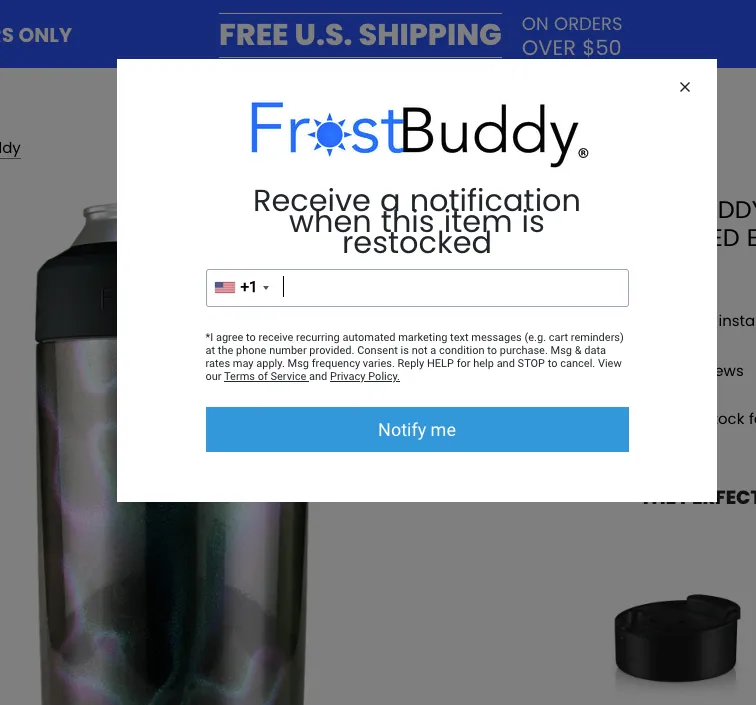
You’ll then set the automated back in stock message to fire when inventory levels reach a certain threshold for the product in question. Here’s what that message looks like (obviously the specific product name and URL will populate based on the opt-in source).
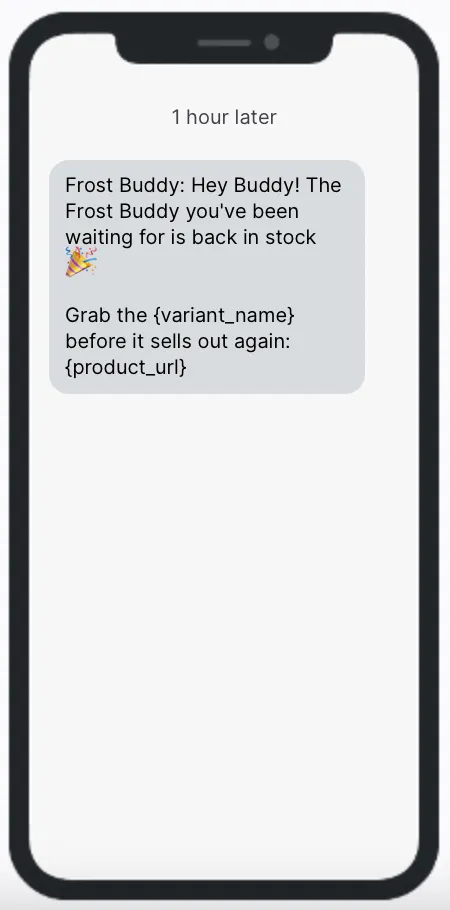
Optimizing Your Back in Stock Automation
First, you’ll want to consider the look and placement of your opt-in banner and popup (if you’re using one). Make sure it’s prominent enough for shoppers to see it, and create a design that aligns with the rest of your website experience.
Beauty and accessories brand Shop Miss A doubles down on their opt-in CTAs, placing a button directly below the “Sold Out” button and adding a banner tab on the edge of the page.
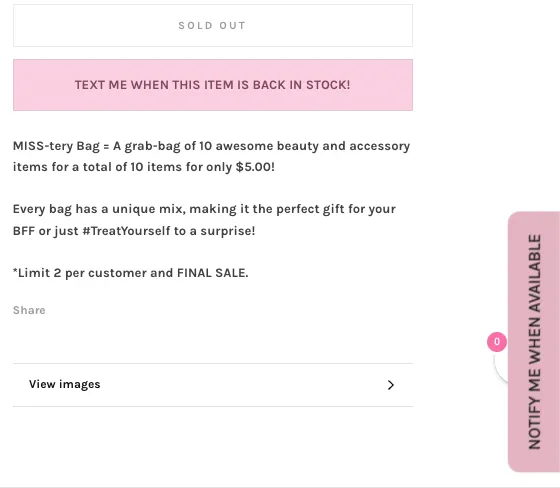
As for the message itself, customize it as much as possible so the recipient has context when they receive it. (After all, it could be a few weeks—or longer—between the time they opt in and the time they actually get the notification.)
The Frost Buddy example above includes the product variant. This is helpful considering that they offer many different color/design variations of the same product—and the recipient might be more likely to return and buy if the message jogs their memory on the specific design they were interested in.
This example from water bottle brand HydroJug includes the variant name for the same reason. You’ll also notice that both brands have customized their message copy in line with their brand. Play around with your phrasing and emojis to make this more than a generic restock alert.
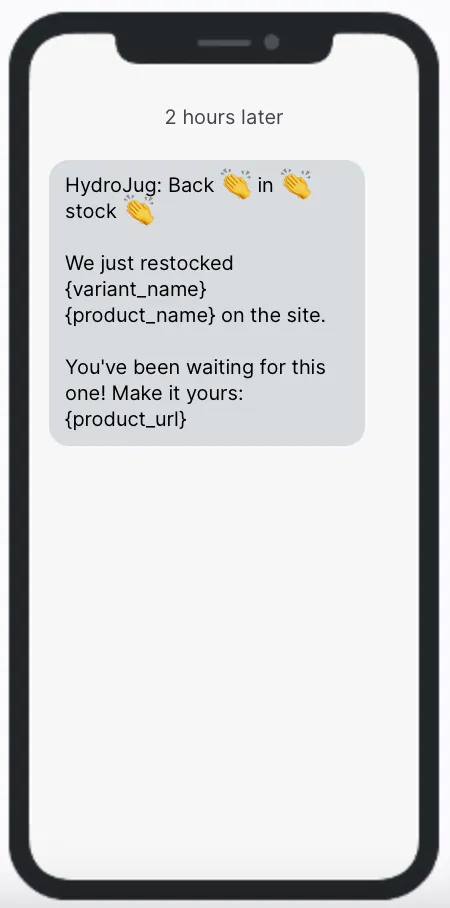
The other factor to consider is the inventory threshold you designate to trigger back in stock notifications. You don’t want to set it so high that it takes months for subscribers to get their restock alert—but you don’t want to set it so low that it might be out of stock again by the time a subscriber clicks through.
If you’re not using SMS automations to their full potential, then you’re leaving revenue on the table—plain and simple. Even a small strategic investment now will pay major dividends later, so start simple with one version of each relevant automation covered here—and then focus on fine-tuning and enhancing as your program grows and matures.



